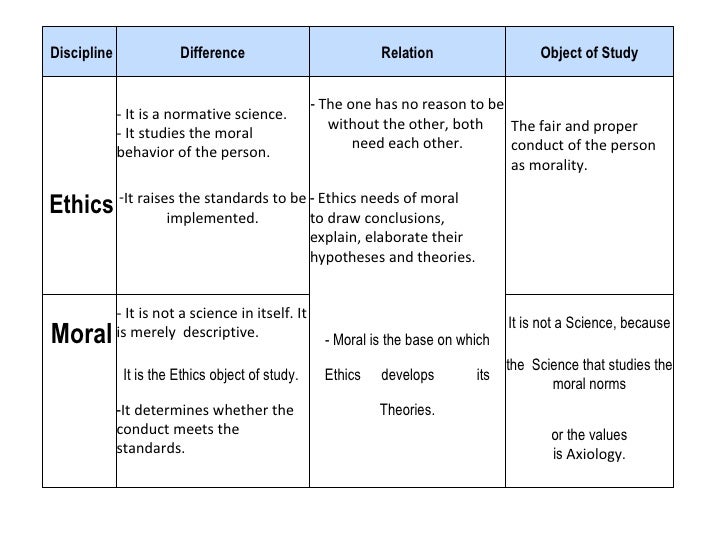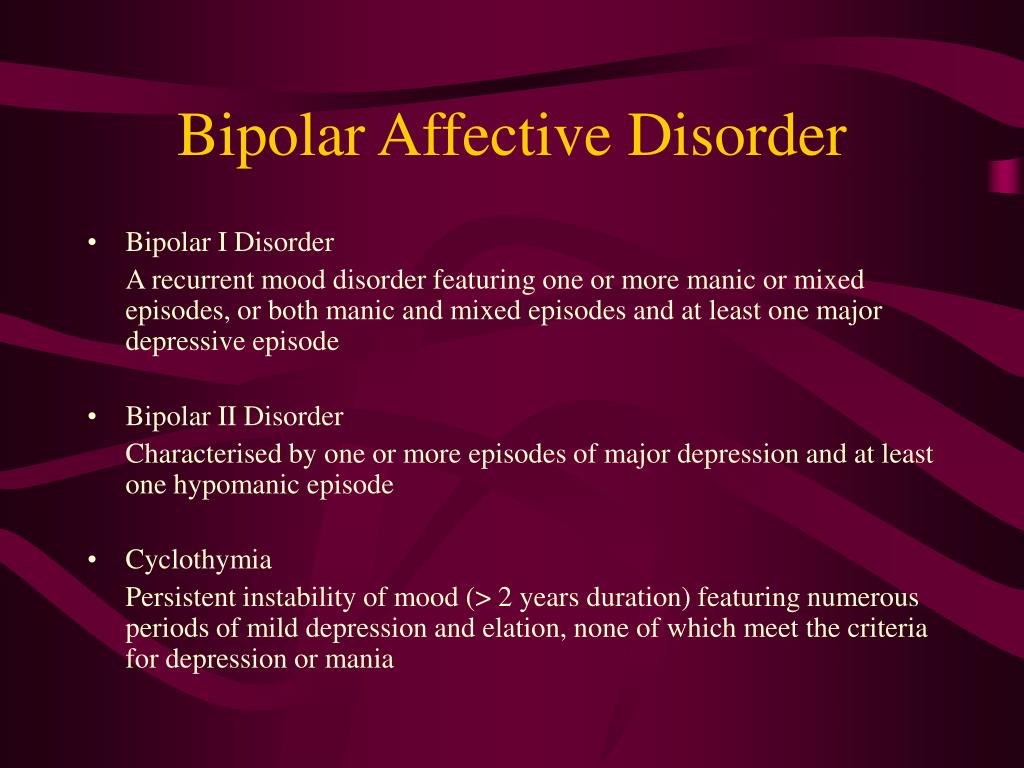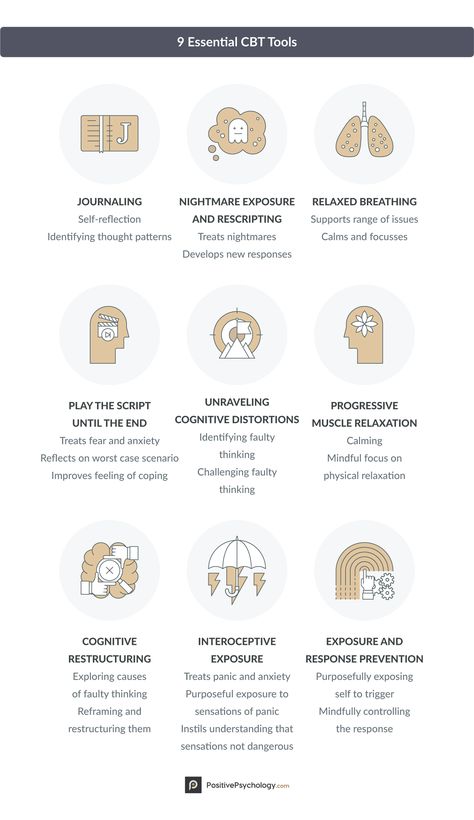Divorce stats us
Divorce Statistics and Facts | What Affects Divorce Rates in the U.S.?
If you spend enough time perusing the internet, you’ll find no shortage of studies, statistics, facts about divorce.
There seems to be a study looking into almost every possible factor that might affect marriages and lead to divorce. These studies have yielded some extremely interesting and – in some cases – downright shocking information about divorce in both the United States and the rest of the world.
Just in case you don’t have 20 hours to spare (it may or may not have taken this long to create this list), we have compiled a nearly exhaustive list with every divorce statistic, study, and fact that we could find. As we move into 2022, our San Diego divorce lawyer team has provided everything you need to know – and quite possibly more- about divorce.
COVID-19 Pandemic Divorce Statistics
As a result of the COVID-19 pandemic and varying states of lockdowns all over the United States and the World, we may be in for the largest single-year increase in divorce in decades. We will keep track of any reports and data that come out over the next year and report here.
What we know so far:
- Jurisdictions all over the world and in nearly every city in the U.S. have reported significant increases in domestic violence.
- Relationships experiencing problems are likely being stressed to the point of breaking by factors such as the lockdown, financial strain and political discord.
- We won’t have a full picture of the fallout until 2021 at the earliest.
U.S. Divorce Rate
U.S. Divorce and Marriage Rates by Year
1. In 2019 (the latest data available), the marriage rate in the United States was 6.1 per 1,000 total population.
2. In the same year, the divorce rate was the U.S. is 2.7 per 1,000 population (with 44 states and D.C. reporting) This is known as the “crude divorce rate”. Although useful for describing changes in divorce rates over time, the crude divorce rate does not provide accurate information on the percentage of first marriages that end in divorce.
3. As of 2019, both marriage rates AND divorce rates in the US are decreasing – with the marriage rate dropping from 8.2 per 1,ooo people in 2000 to 6.1 and the divorce rate from 4.0 in 2000 to 2.7. Recent studies have shown that millennials are choosing to wait longer to get married and staying married longer and are the main driver in the decline of both the marriage and divorce rate in the US.
U.S. Divorce Rate per 1000 Married Women
4. Currently, the divorce rate per 1000 married women is 16.9. Many experts feel that this is a much more accurate measure of true divorce rate than the crude rate.
5. The divorce rate per 1000 married women is nearly double that of 1960, but down from the all-time high of 22.6 in the early 1980s.
6. Almost 50 percent of all marriages in the United States will end in divorce or separation.
7. Researchers estimate that 41 percent of all first marriages end in divorce.
8. 60 percent of second marriages end in divorce.
9. 73 percent of all third marriages end in divorce.
10. The United States has the 6th highest divorce rate in the world. Here is a chart of the top twenty:
Countries with the Highest Divorce Rates in the World: Top 20
How Often Divorce Takes Place in the U.S.
(This information was recalculated based of newly released divorce figures from the CDC for the year 2019. The true figures are likely higher, as the release only includes data from 44 reporting states)
11. Every 42 seconds, there is one divorce in America, That equates to 86 divorces per hour, 2,046 divorces per day, 14,364 divorces per week, and 746,971 divorces per year
12. Every 16 seconds, there is a marriage in the U.S. That equates to 230 marriages per hour, 38,762 marriages per week and 2,015,603 per year.
13. There are nearly 3 divorces in the time it takes for a couple to recite their wedding vows (2 minutes).
14. More than 172 divorces occur during your typical romantic comedy movie (2 hours).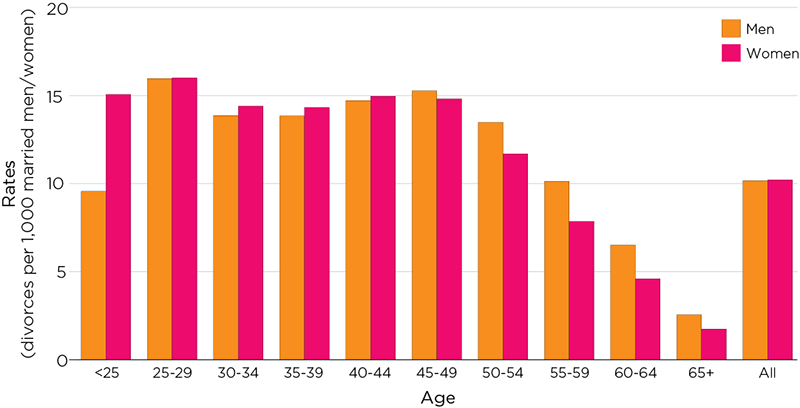
15. 430 divorces happen during the average wedding reception (5 hours).
16. There are 5,975,768 divorces over the course of an average first marriage that ends in divorce (8 years).
17. Over a 40 year period, 67 percent of first marriages terminate.
18. Among all Americans 18 years of age or older, whether they have been married or not, 25 percent have gone through a marital split.
19. 15 percent of adult women in the United States are divorced or separated today, compared with less than one percent in 1920.
20. The average first marriage that ends in divorce lasts about 8 years.
Median duration of first marriages that end in divorce:
Males: 7.8 years
Females: 7.9 years
Median duration of s
econd marriages:Males: 7.3 years
Females: 6.8 years
21. People wait an average of three years after a divorce to remarry (if they remarry at all).
22. In 2011, only 29 out of every 1000 of divorced or widowed women remarried.
Who is Getting Divorce, When, and Why?
Who is Getting Divorced?
23. The average age for couples going through their first divorce is 30 years old.
24. 60 percent of all divorces involve individuals aged 25 to 39.
25. Wives are the ones who most often file for divorce at 66 percent on average. That figure has soared to nearly 75 percent in some years.
26. 5 Professions with highest divorce rates:
- Dancers – 43
- Bartender s- 38.4
- Massage Therapists – 38.2
- Gaming Cage Workers – 34.6
- Gaming Service Workers – 31.3
27. 5 Professions with lowest divorce rates:
- Farmers – 7.63
- Podiatrists – 6.81
- Clergy – 5.61
- Optometrists – 4.01
- Agricultural Engineers – 1.78
U.S. Divorce Rate by Occupation
Data comes from the
| Occupation | Divorce Rate |
|---|---|
| Dancers | 43 |
| Bartenders | 38. 4 4 |
| Massage Therapists | 38.2 |
| Gaming Cage Workers | 34.6 |
| Gaming Service Workers | 31.3 |
| Food and Tobacco Machine Operators | 29.7 |
| Telephone Operators | 29.3 |
| Textile Machine Operators | 29 |
| Nurses | 28.9 |
| Home Care Aids | 28.7 |
| Entertainers | 28.4 |
| Bellhops and Concierges | 28.4 |
| Telemarketers | 28.1 |
| Waitstaff | 27.1 |
| Roofers | 26.8 |
| Maids | 26.3 |
| Corrections Workers | 21.3 |
| Law Enforcement | 14.47 |
| Doctors and Surgeons | 9.23 |
| Mechanical Engineers | 9.22 |
| Medical Scientists | 9.11 |
| Other Scientists | 8.79 |
| Legislators | 8. 74 74 |
| Audiologists | 7.77 |
| Dentists | 7.75 |
| Farmers | 7.63 |
| Podiatrists | 6.81 |
| Clergy | 5.61 |
| Optometrists | 4.01 |
| Agricultural Engineers | 1.78 |
*bonus: Law enforcement and police divorce rate is 14.47, while the rate for corrections workers is 21.3.
28. For instance, the groups with the most prolific experience of marriages ending in divorce are downscale adults (adults making less than $20,000
annually) (39 percent), Baby Boomers (38 percent), those aligned with a non-Christian faith (38 percent), African-Americans (36 percent), and people who consider themselves
to be liberal on social and political matters (37 percent).
29. Among the population segments with the lowest likelihood of having been divorced subsequent to marriage are Catholics (28 percent), evangelicals (26 percent),
upscale adults (adults making more than $75000 annually) (22 percent), Asians (20 percent) and those who deem themselves to be conservative on social and
political matters (28%).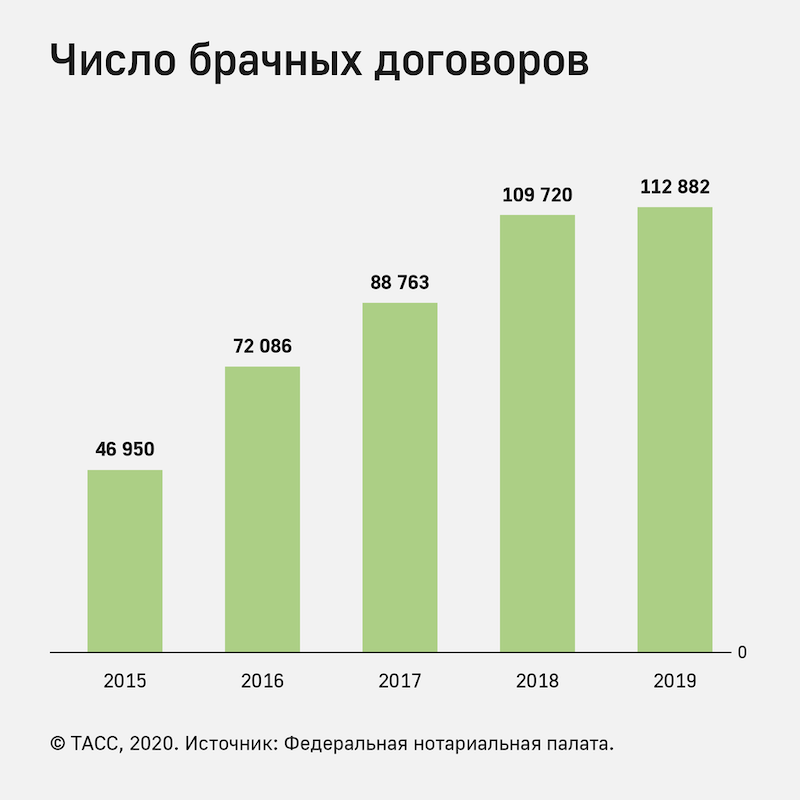
30. Divorce Rate By Ethnicity ( for women ):
| Year | 25-29 yrs | 30-34 yrs | 35-39 yrs | 40-49 yrs | 50-59 yrs | 60-69 yrs | 70 + |
|---|---|---|---|---|---|---|---|
| White | |||||||
| 1996 | 19.7 | 26.1 | 32.2 | 40.8 | 36.1 | 26.6 | 17.2 |
| 2001 | 19.9 | 24.4 | 33.5 | 40.6 | 41.8 | 29.6 | 18 |
| 2004 | 12.4 | 23.2 | 30.5 | 39.1 | 44.3 | 33.9 | 18.1 |
| 2009 | 14.2 | 22.1 | 27.6 | 36.3 | 41.1 | 36.9 | 21.9 |
| Black | |||||||
| 1996 | 14.7 | 28 | 40.7 | 44.5 | 42 | 35.6 | 21.9 |
| 2001 | 20.6 | 24.5 | 37.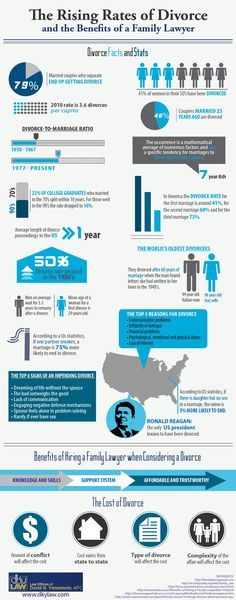 3 3 | 42.2 | 44.7 | 33.8 | 25.4 |
| 2004 | 11 | 20.1 | 37.1 | 39 | 47.8 | 37.2 | 26.7 |
| 2009 | 14.6 | 23.9 | 32.7 | 35 | 48.2 | 40.3 | 27.8 |
| Asian | |||||||
| 1996 | 9.3 | 12 | 14.3 | 22.8 | 23.2 | 4.9 | 8.5 |
| 2001 | 4.1 | 10.7 | 18.1 | 17.5 | 22.7 | 9.9 | 5 |
| 2004 | 1.9 | 6.1 | 11.4 | 20.1 | 19.9 | 9.6 | 9.1 |
| 2009 | 1.3 | 7.8 | 13.2 | 20.6 | 18.5 | 16 | 11.3 |
| Hispanic | |||||||
| 1996 | 15.5 | 17.4 | 24 | 33.2 | 31.7 | 25.6 | 20.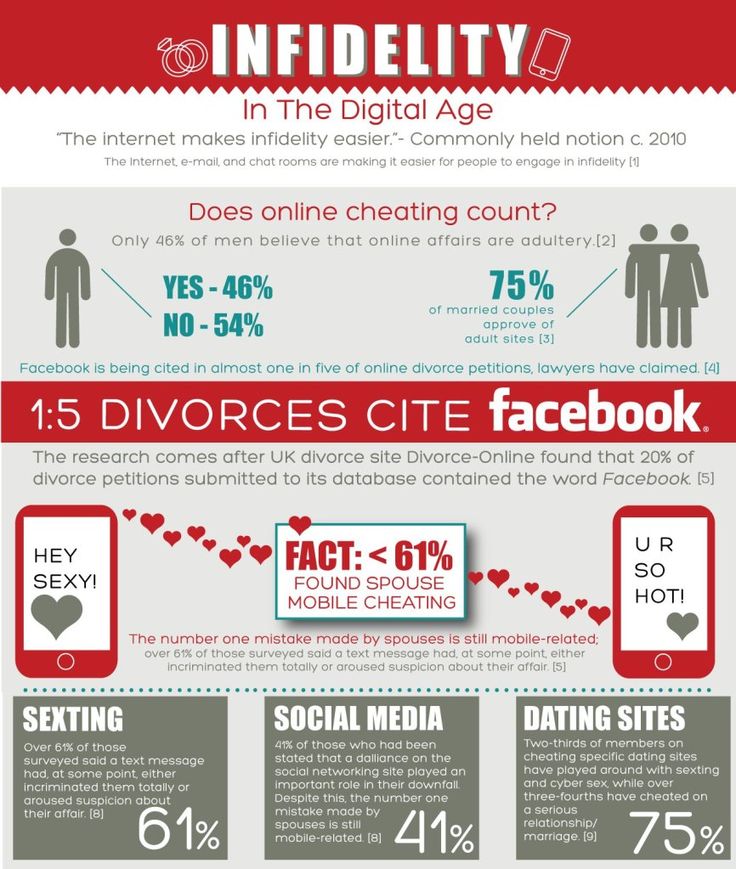 3 3 |
| 2001 | 12.5 | 15.5 | 26.5 | 28.5 | 34 | 26.5 | 21.5 |
| 2004 | 8.8 | 16.3 | 24.7 | 24.4 | 33.1 | 23.9 | 19.5 |
| 2009 | 10.5 | 16.3 | 18.1 | 23.7 | 30.2 | 25 | 24.2 |
Military Divorce
31. According to the Pentagon, the military divorce rate is 3.4 percent in the 2013 fiscal year. However, the rate was significantly higher in military women at 7.2 percent.
32. The Divorce rate among enlisted troops was 3.8 percent. Among officers, the divorce rate was 1.9 percent.
33. The Air Force has the highest divorce rate among enlisted troops of any military branch at 4.3 percent.
34. The divorce rate among U.S. Navy Seals is over 90 percent.
Divorce Rate in Specific Population Segments
35. The divorce rate among people 50 and older has doubled in the past 20 years, according to research by Bowling Green State University.
36. The divorce rate among couples where one spouse is in jail or prison for one year or more is 80 percent for men and close to 100 percent for women.
Same-Sex Divorce Statistics
37. About 1 percent of married same-sex couples get divorced each year, while about 2 percent of married straight couples divorce.
38. According to figures from the UK’s Office of National Statistics, lesbian couples are nearly twice as likely to end a marriage or civil union than gay male couples are.
39. In the United States, the divorce rate is 3.1 per 1000 people that allow same-sex marriage, and 3.9 in states that prohibit it.
When Do People Divorce?
40. The average length of a marriage that ends in divorce is 8 years.
41. January is considered “divorce month”. People start looking for information before the New Year starts, but they can’t do much until the attorneys are back in the office. January 12-16 seems to be the magic week for filings.
Why People are Divorcing in the United States
42. Lack of commitment is the most common reason given by divorcing couples according to a recent national survey. Here are the reasons given and their percentages:
Lack of commitment is the most common reason given by divorcing couples according to a recent national survey. Here are the reasons given and their percentages:
- Lack of commitment 73%
- Argue too much 56%
- Infidelity 55%
- Married too young 46%
- Unrealistic expectations 45%
- Lack of equality in the relationship 44%
- Lack of preparation for marriage 41%
- Domestic Violence or Abuse 25%
(Respondents often cited more that one reason, therefore the percentages add up to much more than 100 percent)
What Makes People More or Less Likely to Divorce?
Your Age
43. 48 percent of those who marry before the age of 18 are likely to divorce within 10 years, compared to 25 percent of those who marry after the age of 25.
44. 60 percent of couples married between the age of 20 -25 will end in divorce.
45. Those who wait to marry until they are over 25 years old are 24 percent less likely to get divorced.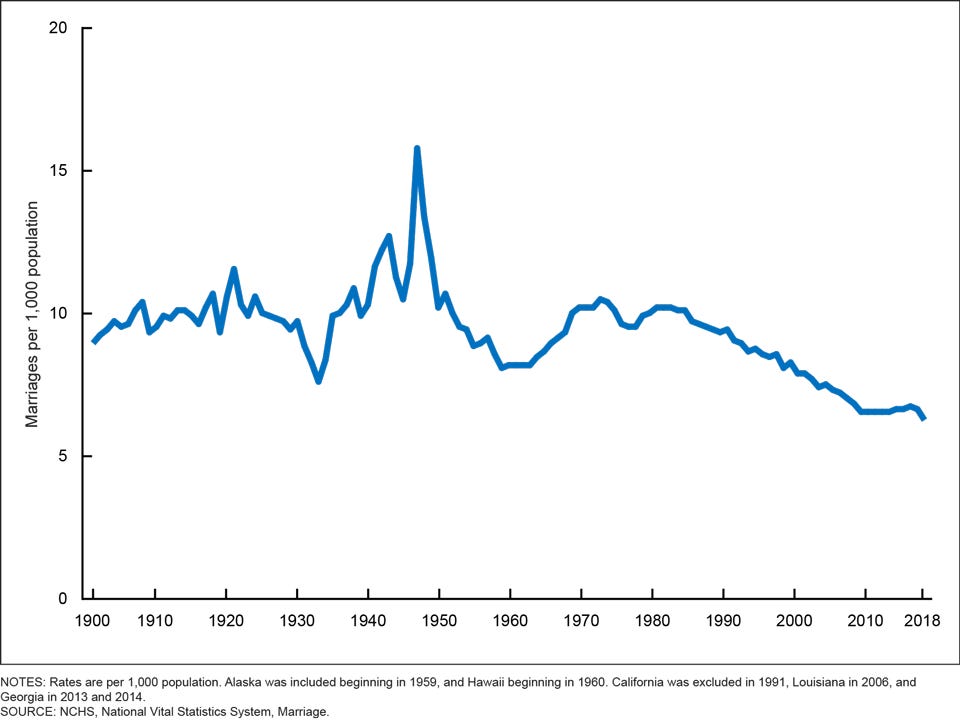
If you or your Partner Have Been Married Before
46. If both you and your partner have had previous marriages, you are 90 percent more likely to get divorced than if this had been the first marriage for both of you.
Religion and Divorce
47. If a person has strong religious beliefs, the risk of divorce is 14 percent less and having no religious affiliation makes you 14 percent more likely to get divorced.
48. If you’re an evangelical Christian adult who has been married, there’s a 26 percent likelihood that you’ve been divorced—compared to a 28 percent chance for Catholics and a 38 percent chance for non-Christians.
49. According to Dr. Jennifer Glass, one of the strongest factors predicting divorce rates (per 1000 married couples) is the concentration of conservative or evangelical Protestants in that county. The correlation can be seen on this figure: (insert divorce counties image)
Education and Intelligence
50. High School dropouts are 13 percent more likely to get divorced.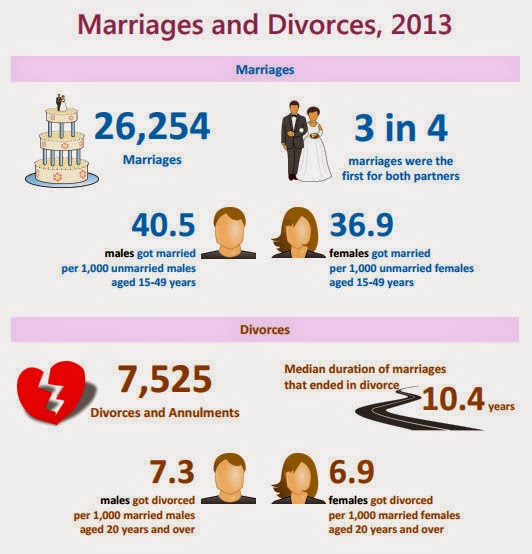
51. Individuals who have attended college have a 13 percent lower risk of divorce.
52. Those with “below average” IQs are 50 percent more likely to be divorced than those with “above average” IQs.
Political Affiliation
53. Political affiliation and it’s impact on divorce: Conservatives are the least likely to be divorced: Conservative 28 percent, Liberal 37 percent, Moderate 33 percent.
54. If you live in a red (Republican) state, you are 27 percent more likely to get divorced than if you live in a blue (Democrat) state.
Cohabitation – If you lived with your partner before you got married
55. 60 percent of cohabiting couples will eventually marry. However, living together prior to marriage can increase the chance of getting divorced by as much as 40 percent.
56. If you are a female serial cohabiter – a woman who has lived with more than one partner before your first marriage – then you’re 40 percent more likely to get divorced than women who have never done so.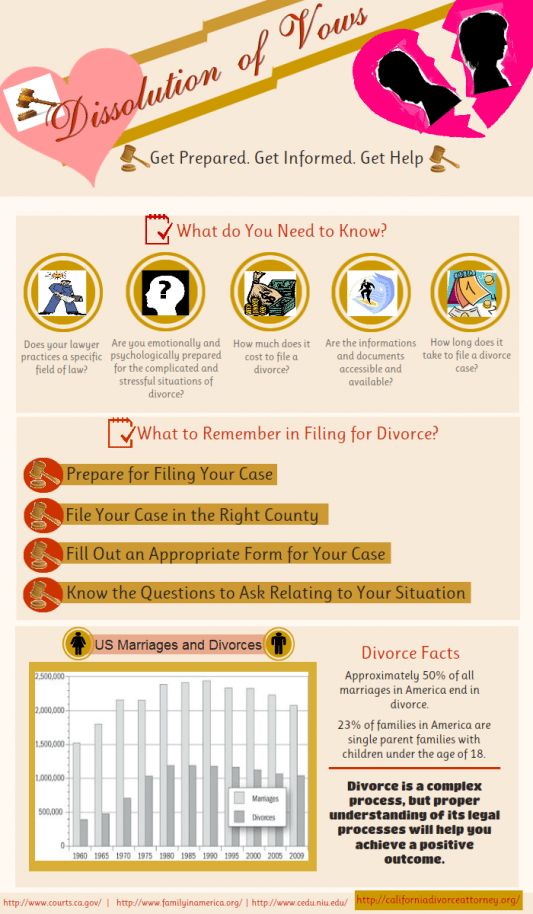
Where You Met
57. According to this study at least, if you met your spouse in high school, college, or grad school, you are 41 percent less likely to get divorced.
58. The other major difference was couples who met in bars were 24 percent more likely to get divorced than expected.
Your Sexual History
59. Women who lost their virginity as a teenager are more than twice as likely to get divorced in the first 5 years of marriage than women who waited until age 18 or older.
60. A 2011 study at the University of Iowa found that for both men and women, the loss of virginity before age 18 was correlated with a greater number of occurrences of divorce within the first 10 years of marriage.
61. When compared to women who began sexual activity in their early 20s, girls who initiated sexual activity at ages 13 or 14 were less than half as likely to be in stable marriages in their 30s. – (in this study a stable marriage was defined as a marriage of over five years).
THE HARMFUL EFFECTS OF EARLY SEXUAL ACTIVITY AND MULTIPLE SEXUAL PARTNERS AMONG WOMEN
62. Women with 6 or more premarital sexual partners are almost 3 times less likely to be in a stable marriage.
Where You Live Impacts Your Likelihood to Be Divorced
63. According to the CDC, the five states with the highest divorce rates are:
- Nevada at 5.6
- West Virginia at 5.2
- Arkansas at 5.3
- Idaho at 4.9
- Oklahoma at 5.2
64. The five states with the lowest divorce rate are:
- Iowa at 2.4
- Illinois at 2.6
- Massachusetts at 2.7
- North Dakota at 2.7
- Pennsylvania at 2.8
65. Arkansas has the highest rate of individuals married 3 or more times. Men and women in Arkansas are twice as likely to be married 3 or more times than the national average.
Your Habits, Your Marriage
66. The risk of divorce was said to be almost doubled – 97 percent higher – when the mother went out to work but her husband made a “minimal contribution” to housework and childcare.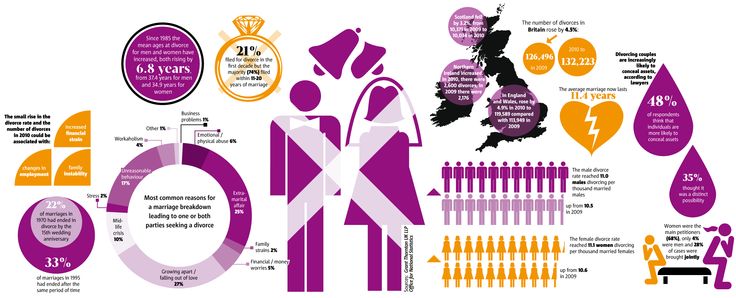
67. In 2011, Facebook was cited as a major contributor to 1/3 of divorce petitions examined by one U.K. study.
68. In a study by the University of Rochester, researchers said that watching romantic movies and having a conversation around it helps in lowering the divorce rates from 24 to 11 percent in marriages of three years.
69. Pornography addiction was cited as a factor in 56 percent of divorces according to a recent study.
Your Parent’s Relationship
70. If your parents are happily married, your risk of divorce decreases by 14 percent.
71. If your parents married others after divorcing, you’re 91 percent more likely to get divorced.
72. According to Nicholas Wolfinger in “Understanding the Divorce Cycle”, the risk of divorce is 50 percent higher when one spouse comes from a divorced home and 200 percent higher when both partners do.
73. In addition, children of divorce are 50 percent more likely to marry another child of divorce.
74.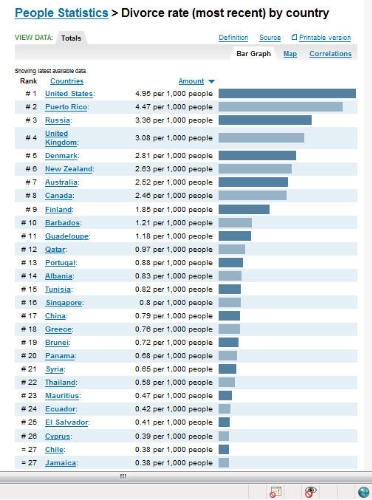 Certain studies have shown that daughters of divorced parents have a 60 percent higher divorce rate in marriages than children of non-divorced parents while sons have a 35 percent higher rate.
Certain studies have shown that daughters of divorced parents have a 60 percent higher divorce rate in marriages than children of non-divorced parents while sons have a 35 percent higher rate.
If you Have Kids or Not
75. The divorce rate for couples with children is as much as 40 percent lower than for those without children.
76. Half of all children in the United States will witness the ending of a parent’s marriage.
77. Of this half, close to 50 percent will also see the breakup of a parent’s second marriage.
78. If you have twins or triplets, your marriage is 17 percent more likely to end in divorce than if your children are not multiples.
79. If you have a daughter, you’re nearly 5 percent more likely to divorce than if you have a son.
80. When there are as many as three daughters that difference spiked to 10 percent.
81. Fathers are significantly less likely – 3 percent – to be living with their children if they have daughters versus sons.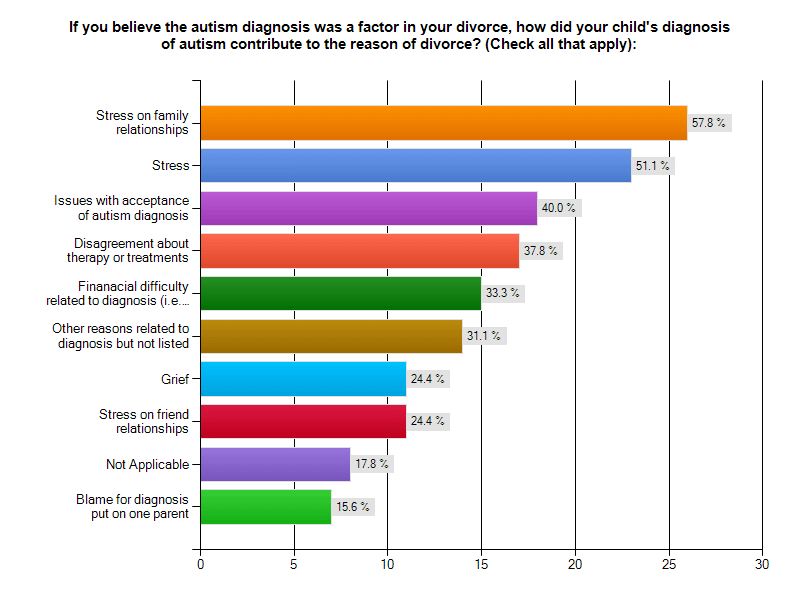
82. Having a baby before marriage can increase the risk of divorce by 24 percent.
Your Finances and Their Effect on Divorce Rates
83. An annual income of over $50,000 can decrease the risk of divorce by as much as 30% versus those with an income of under $25k.
84. Feeling that one’s spouse spent money foolishly increased the likelihood of divorce 45 percent for both men and women.
85. Couples that argue about finances at least once a week are 30 more likely to get divorced.
86. The same study also found that couples with no assets at the beginning of a three-year period are 70 percent more likely to divorce by the end of that period than couples with $10,000 in assets.
Addiction, Mental Illness and Divorce
87. Couples are an astonishing 76-95% more likely to get divorced if only one of them smokes. The amount increases when the wife is the partner with the habit.
88. While couples who both smoke have it a bit better, a 1998 study found they are still 53% more likely than non-smoking couples to end their marriage.
89. Each liter of alcohol consumed raises the chance of divorce by 20%! Factor in that the average American drinks 9.4 liters of alcohol per year, raising their divorce likely hood by 188%!
90. According to a 9-year study by the University of Buffalo, couples who have similar heavy drinking patterns – either both are heavy drinkers or both are not- are more likely to stay together.
91. However, if one spouse is a heavy drinker and the other is not, they are 60 percent more likely to get divorced.
92. A multi-national study of mental disorders, marriage and divorce published in 2011 found that a sample of 18 mental disorders all increased the likelihood of divorce — ranging from a 20 percent increase to an 80 percent increase in the divorce rate. Addictions and major depression were the highest factors, with PTSD (Post-Traumatic Stress Disorder) also significant.
93. A recent study of divorce petitions found that nearly 15 percent of them cited video game addiction as a major factor in the decision to get divorced.
Divorce, Child Support and Child Custody
94. Forty-three percent of children in the United States are being raised without their fathers.
95. When the parents are happily married, the risk of divorce of their children decreases by 14 percent.
96. 90% of divorced mothers have custody of their children.
97. Over 79 percent of custodial mothers receive a child support award, while just under 30 percent of custodial fathers receive one.
98. 65% of divorced mothers receive no child support.
99. Over 46 percent of non-custodial mothers completely default on child support, compared to only 27 percent of non-custodial fathers.
Friend’s and Relative’s Impact on Divorce
100. If a close friend gets divorced, you are 147% more likely to become divorced and 33% more likely if a friend of a friend is divorced.
101. Studies at the University of California and Brown University cite that when a married person works with someone who is in the process of divorcing, it increases the married person chances of divorce by 75%.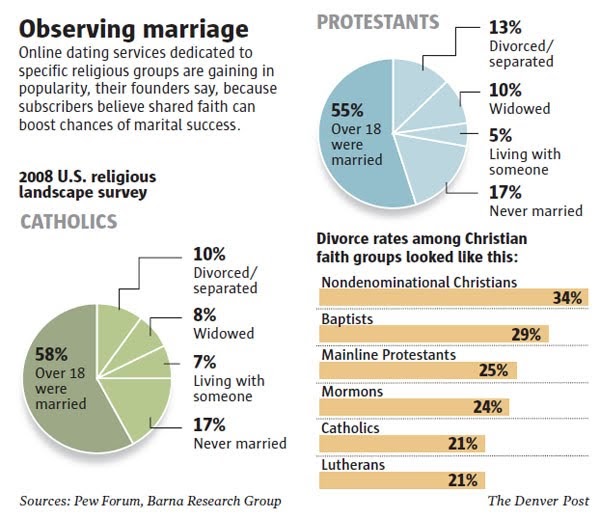
102. These same studies also found that people with divorced sisters or brothers are 22% more likely to get divorced than if siblings are not divorced.
103. In a large-scale Canadian survey, 19 percent of men reported a significant drop in social support post-divorce.
The Financial Effects of Divorce
104. The average total cost of divorce in the United States is $15,000.
105. Families with children that were not poor before the divorce see their income drop as much as 50 percent.
106. Almost 50 percent of the parents with children that are going through a divorce move into poverty after the divorce.
107. 27% of recently divorced women had less than $25,000 in annual household income compared with 17% of recently divorced men.
108. 60% of people under poverty guidelines are divorced women and children.
The Toll a Divorce Takes
109. A new study entitled “Divorce and Death” shows that broken marriages can kill at the same rate as smoking cigarettes. Indications that the risk of dying is a full 23 percent higher among divorcées than married people.
Indications that the risk of dying is a full 23 percent higher among divorcées than married people.
110. One researcher determined that a single divorce costs state and federal governments about $30,000, based on such things as the higher use of food stamps and public housing as well as increased bankruptcies and juvenile delinquency.
111. The nation’s 1.4 million divorces in 2002 are estimated to have cost the taxpayers more than $30 billion.
112. An article in the New York Times stated that – of couples who seek marriage counseling – 38 percent end up divorced just two years later.
113. Only around five percent of divorces are decided in the courtroom. This means in 95 percent of divorce cases, the parties and their family law attorneys are able to settle issues amicably or in mediation.
Bonus
The Five Most Expensive Divorces of all Time
According to an article on Divorce Help 360 here are the most expensive divorces of all time as well as the most expensive celebrity divorces of all time:
- Harold and Sue Ann Hamm – $5.
 3 billion
3 billion - Rupert and Anna Murdoch – $1.7 billion
- Bernie and Slavica Ecclestone – $1.2 billion
- Adnan Khashoggi and Soraya Khashoggi – $875 million
- Craig and Wendy McCaw – $460 million
Most Expensive Celebrity Divorces
- Mel and Robyn Gibson – $425 million
- Arnold Schwarzenegger and Maria Shriver – $250-$300 million
- Michael and Juanita Jordan – $168 million
Contact our reputable San Diego family law attorneys for a consultation! Call today! 619-284-4113
48 Divorce Statistics [Updated 2023]
- Home ›
- On Divorcing ›
- 48 Divorce Statistics in the U.S. Including Divorce Rate, Race, & Marriage Length
- Home ›
- On Divorcing ›
- 48 Divorce Statistics in the U.S. Including Divorce Rate, Race, & Marriage Length
4 Min Read
By Divorce. com staff
com staff
Updated Jan 03, 2023
- The United States has the sixth highest divorce rate in the world, with 40% to 50% of married couples filing for a divorce.
- The United States Census Bureau report suggests that marriage and divorce rates dropped from 2009 to 2019.
- Usually, second or third marriages in the United States have a higher divorce rate: 60% of second marriages and about 73% of third marriages end in divorce.
- Couples going through their first divorce are around the age of 30. Married couples between the ages of 20 to 25 are 60% likely to get a divorce.
- Black women divorce at a higher rate (38.9%) than women of any other race.
- The military divorce rate is 3% on average. In 2019 alone, 30,608 military marriages ended in divorce.
- Baby Boomers have the highest divorce rate among other generations - 34.9%.
- Three states – Maryland, New Jersey, and Massachusetts – have some of the United State’s highest median income levels and lowest rates of divorce.
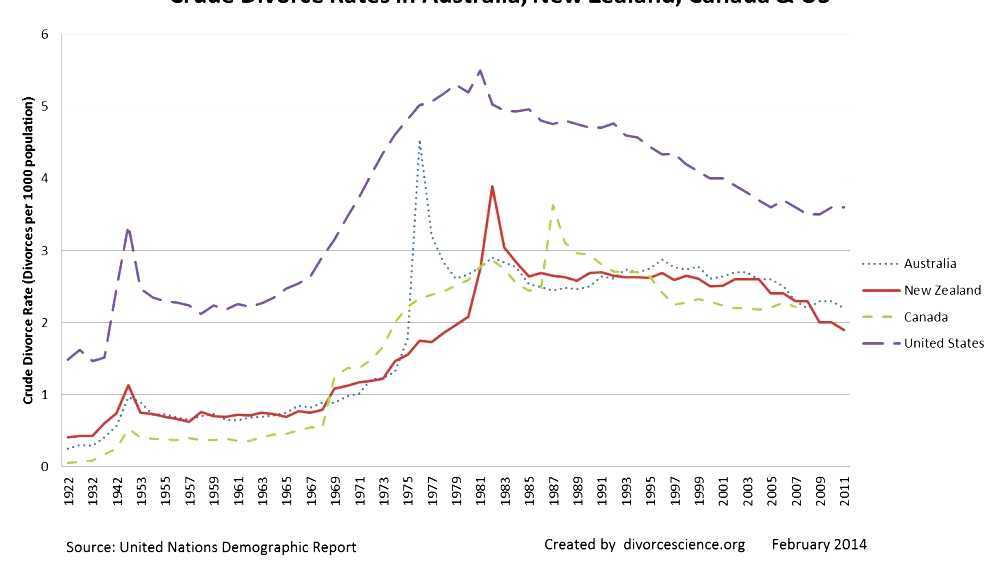
- Alabama, Kentucky, and Oklahoma have some of the United States’ lowest median income levels and the highest divorce rates.
What is the divorce rate in the U.S.?
The national average divorce rate in the U.S. in 2020 was 2.3 per 1,000 people, as the Centers for Disease Control reported. It is almost 64% lower than the average of 3.6 per 1,000 people in 2010. (Excluding data from California, Georgia, Hawaii, Indiana, Louisiana, and Minnesota.)
- In 2019, CDC.gov reported an almost 2.7 divorce rate per 1,000 people. (This excludes California, Hawaii, Indiana, Minnesota, and New Mexico data.)
- The Centers for Disease Control also reported 630,505 total divorces in the U.S. in 2020.
The divorce rate in America in 2021 was estimated to be around 45% before Covid-19.
However, by mid-2021, several legal professionals noticed an increase in divorce filings, most likely due to restrictions being eased. As a result, in 2022, some sources predict the divorce rate to reach at least 44.2%.
As a result, in 2022, some sources predict the divorce rate to reach at least 44.2%.
U.S. states with the highest divorce rate
These are the states with the highest divorce rates per 1,000 people as of 2022:
- Arkansas: 10.7
- Oklahoma: 10.4
- Nevada: 10.2
- New Mexico: 10.2
- Kentucky: 10.1
- Wyoming: 10.0
- Delaware: 9.4
- Utah: 9.4
- Kansas: 9.2
- Alabama/Missouri: 9.1
Arkansas has the highest divorce rate, with 10.7 divorces per 1,000 married people. It is also one of several states with the youngest age at the first marriage.
U.S. states with the lowest divorce rate
These are the states with the lowest divorce rate per population of 1,000 as of 2022:
- Maine: 4.8
- District of Columbia: 4.8
- South Dakota: 6.
 0
0 - Pennsylvania: 6.1
- New York: 6.1
- Illinois: 6.2
- New Jersey: 6.3
- Iowa: 6.3
- Wisconsin: 6.4
- Massachusetts: 6.4
Main and the District of Columbia are tied for the lowest divorce rate; more than half of the states with the lowest divorce rate are in the northeastern part of the United States.
Divorce rate by year
Divorce rates have continuously declined since the end of the 20th century, as reported by the Centers for Disease Control and Prevention.
- In 2010, there were 3.5 divorces per 1,000 people
- 2011 - 3.6
- 2012 - 3.4
- 2013 - 3.3
- 2014 - 3.2
- 2015 - 3.1
- 2016 - 3
- 2017 - 2.9
- 2018 - 2.9
- 2019 - 2.
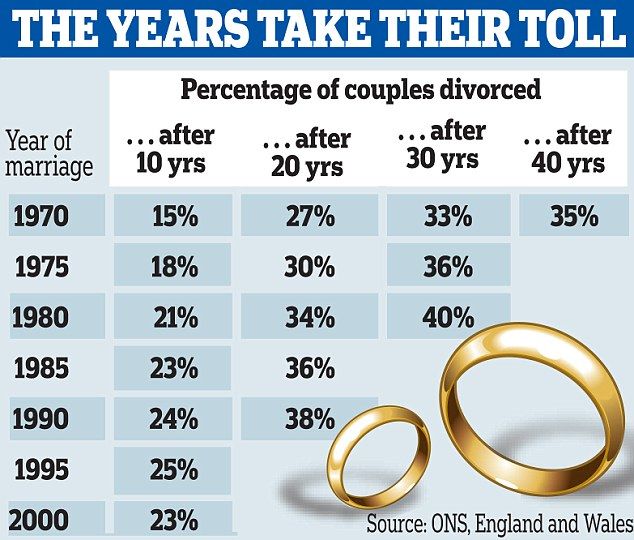 7
7 - 2020 - 2.3
Who files for divorce more?
According to sociological research by M.J.Rosenfeld, women file for divorce twice more often as men.
Almost 69% of women initiate divorce in the U.S. compared to 31% of men. Surveys show that such disparity results from women’s high and later unmet expectations of emotional support from men.
The rate of divorce for women
The divorce rate for women in the United States in 2022 is 16.9 divorces per 1,000 married women. Experts suggest this is a more accurate statistic of the actual divorce rate than the crude rate.
In 2018, the U.S. Census Bureau revealed that 7.7 out of every 1,000 married women over 15 got divorced. Some prognoses suggest that in 2022, this number is about to increase.
Despite the rate of marriage steadily declining compared to divorce rates, experts predict that between 40% to 50% of marriages today will ultimately end in divorce.
How does the rate of divorce differ for women?
Women get divorced at a significantly higher rate compared to men. In particular, they get divorced at a rate of 7.7 per 1,000 citizens in the United States, according to the CDC.gov report. At the same time, the current national divorce rate is 2.3 per 1,000 people.
These are the states with the highest rates of divorce for women:
- Arkansas – 13.1 divorces per 1,000
- South Dakota – 12.1
- Oklahoma – 10.8
- Kentucky – 10.5
- Oregon – 10.1
- Indiana – 9.9
- Nevada – 9.6
- Utah – 9.3
- Missouri – 9.2
- Tennessee – 9.1
These are the states with the lowest divorce rates for women:
- Puerto Rico – 4.2 divorces per 1,000
- North Dakota – 4.7
- Rhode Island – 4.
 9
9 - New York – 5.7
- Wisconsin – 6.2
- Vermont – 6.3
- Illinois – 6.6
- California – 6.7
- Michigan – 6.9
Rates of divorce for women across the U.S.
There is a consistent trend regarding marriage and divorce rates among women across the U.S. For example, Black women usually display the lowest marriage probability and the highest divorce rates.
At the same time, Asian women get married at a higher rate and are less likely to get divorced.
These are the following divorce rates for women across the United States:
- African-Americans: 33% divorces per 1,000 married residents
- Hispanic women: 22% divorces per 1,000 married residents
- White women: 19% divorces per 1,000 married residents
- Asian women: 11% divorces per 1,000 married residents
What is the rate of marriage in the U.
 S.?
S.?- Marriage rates in the U.S. have continuously declined for several decades. In 2018, the marriage rate was 31.3 per 1,000 unmarried women, with a 6.5 average for both genders.
- In 2019, there were 2,015,603 registered marriages, making the marriage rate even lower - 6.1. In 2020, it dropped even lower to 5.1.
- In 2021, 67.54 million men and 68.33 million women were married in the United States.
U.S. states with the highest rates of marriage
These are the 10 states with the highest rates of marriage:
- Utah: 56% of the population is married
- Idaho: 55%
- Wyoming: 53%
- Nebraska: 53%
- Iowa: 53%
- Kansas: 52%
- Minnesota: 52%
- South Dakota: 52%
- North Dakota: 52%
- New Hampshire: 52%
U.
 S. states with the lowest rates of marriage
S. states with the lowest rates of marriageThese are the ten states with the lowest rates of marriage:
- Louisiana: 44% of the population is married
- New York: 44%
- Rhode Island: 45%
- Mississippi: 45%
- New Mexico: 45%
- Nevada: 46%
- Florida: 46%
- Massachusetts: 46%
- California: 47%
- Georgia: 47%
The average length of marriage in America
The average length of marriage in the United States is 8.2 years. Although the national average for marriage in the United States is slightly over eight years, couples in West Virginia and Maine have the longest-lasting unions (22.3 years), according to research.
New York City is also among the U.S. locations with the longest marriages. The typical marriage length for those who live in the Big Apple is 12. 2 years. However, some scholars believe the actual number is closer to seven years because the divorce process takes a year to complete.
2 years. However, some scholars believe the actual number is closer to seven years because the divorce process takes a year to complete.
Many resources estimate the U.S. divorce rate to be about 50%, but the actual percentages of marriages that end in divorce vary between 40% to 50%.
For those who fear their marriage will end in divorce, this statistic is reassuring and suggests they are more likely to stay married than divorced.
Divorce Demographics for adults over the age of 15
The CDC.gov report provides the following demographics for the divorced population over 15 years old:
- Average age: 45.8
- Bachelor’s degree or higher: 30.1%
- Employed: 63.3%
- Unemployed: 36.7%
- Living below the poverty line: 11.9%
- Living with children under 18: 23.2%
- Homeowner: 67.4%
- Renter: 32.6%
How does income impact divorce?
The following statistics demonstrate the explicit dependence of divorce rates on financial stability. Namely, the higher the income, the lower the percentage of divorces, and vice versa. For instance, half of the states with the most insufficient median income are among the top ten with the highest divorce rates.
Namely, the higher the income, the lower the percentage of divorces, and vice versa. For instance, half of the states with the most insufficient median income are among the top ten with the highest divorce rates.
Median income levels across the U.S.
These are the states with the highest median household income:
- Maryland - $87,063 (low divorce rates)
- New Jersey - $85,245 (the 6th state with the lowest divorce rate)
- Massachusetts - $84,385 (the lowest divorce rate nationwide)
- Hawaii - $83,173
- Connecticut - $79,855 (the 5th state with the lowest divorce rate)
- California - $78,672
- New Hampshire - $77,923
- Alaska - $77,790
- Washington - $77,006
- Virginia - $76,398
These are the states with the lowest median household income:
- Mississippi $46,511
- West Virginia $48,037
- Arkansas $49,475 (the highest divorce rate nationwide)
- Louisiana $50,800
- New Mexico $51,243 (the 4th highest divorce rate)
- Alabama $52,035
- Kentucky $52,238
- Oklahoma $53,840 (the 2nd highest divorce rate)
- Tennessee $54,833
- South Carolina $54,864
Income also impacts the decision to marry, seemingly decreasing the divorce rate.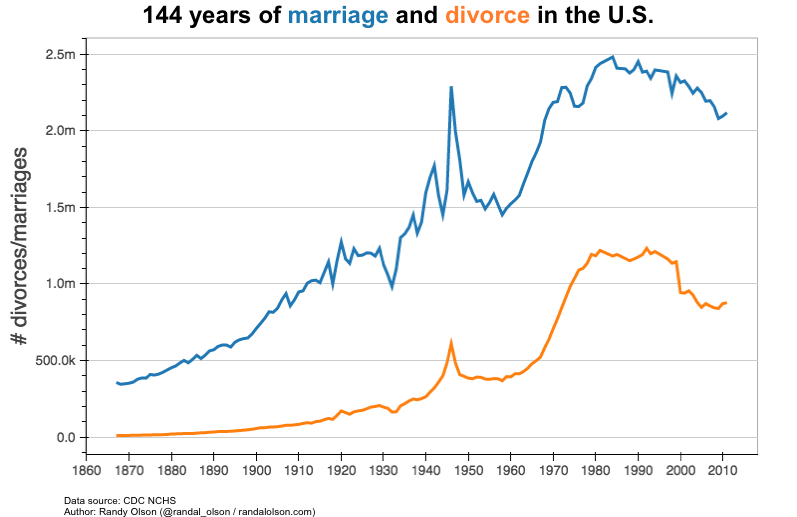
In 2018, the Census board reported that:
- 20% of 18 – 34-year-olds who made $40,000+ per year were unmarried.
- 40% of 18 – 34-year-olds who made $40,000+ per year were married.
Financial difficulties are often cited as the main reason for not getting married among never-married adults, according to research:
- 47% of them have incomes below $30,000
- 40% of them have incomes of $30,000-$75,000
In what year of marriage is divorce most common?
Of the 39% to 50% of marriages ending in divorce, the average length of the marriage is 8 years, according to Census.gov statistics.
The two periods during marriage where divorces occur are usually during the first two years or the fifth to the eighth year of marriage.
Again, even though no conclusive result has been reached, it is expected that the most challenging years in the average marriage are years seven and eight.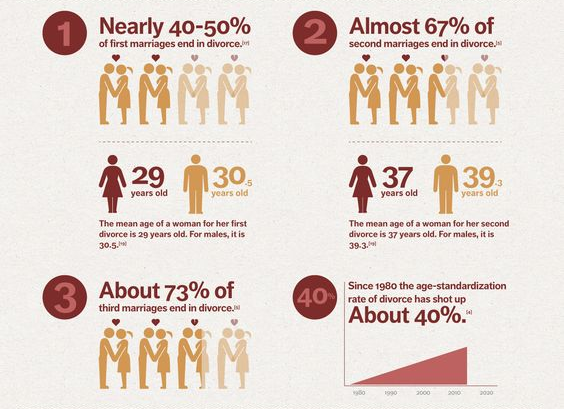 It is often referred to as the “7-year itch.”
It is often referred to as the “7-year itch.”
What is the most common reason for divorce?
- Financial troubles are also another common reason for divorce. According to divorce stats, economic issues cause about 25% of divorces.
- Infidelity or extramarital affairs are the second most frequent reasons for divorces.
- Roughly 20% to 40% of marriages end in divorce because of a cheating partner or infidelity.
- Alcohol or drug use causes about 24% of divorces.
- Married couples who argue constantly are another reason for divorce; about 57.7% of couples get divorced because of daily arguing.
What are the most common reasons for marriage?
According to the 2019 Survey of U.S. adults, the most common reasons to get married are:
- Love – 90%
- Companionship – 66%
- Commitment – 63%
- The desire to have children – 31%
- Finances – 13%
- Legal rights and benefits –10%
- Pregnancy – 6%
How does age impact divorce?
Studies show that 48% of people who get married before 18 are likely to divorce within ten years after the wedding.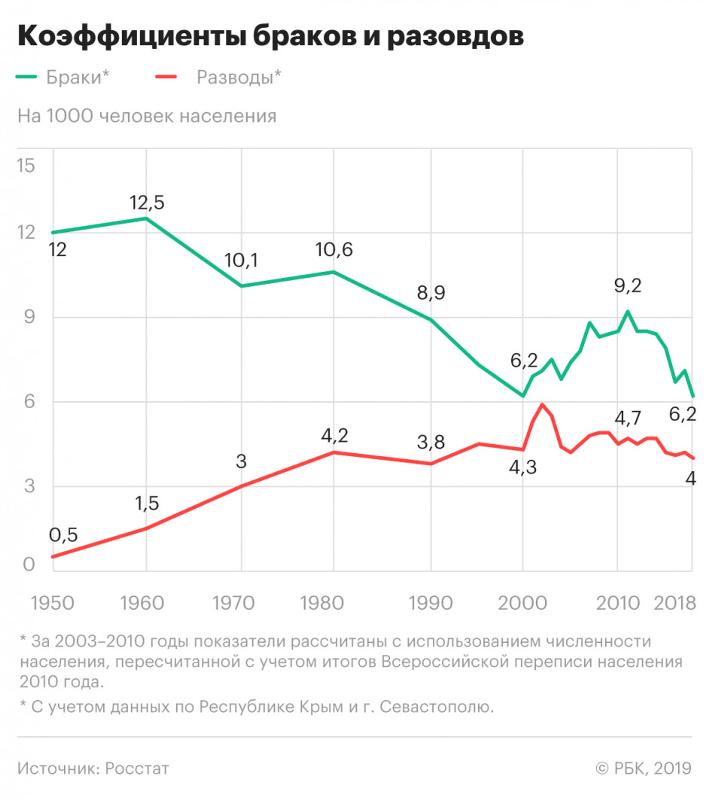 Research also suggests that 60% of couples married between the ages of 20 to 25 will end in divorce.
Research also suggests that 60% of couples married between the ages of 20 to 25 will end in divorce.
Couples who get married between the age of 28 and 32 are less likely to have their marriage end in a divorce, according to research by Dr. N. Wolfinger from Utah University.
The average age at the first divorce
The average age for newly married couples going through their first divorce in the United States is 30 years old. About 34% of all divorces initiate spouses aged 25 to 29. The percentage of people 55 to 64 years old who got divorced for the first time is about 43%.
The divorce rate for people in their sixties has doubled since 1990, from 4.9 to 10.3 in 2008, according to research. This type of divorce is known as a “gray divorce” and can cause severe depression, worse than if one’s partner passed away.
Trends in divorce rates among Baby Boomers have been dramatic. Following their parents’ era (the “Silent Generation”), Boomers who came of age in the late 70s and early 80s started to divorce at a rate not seen before 1970.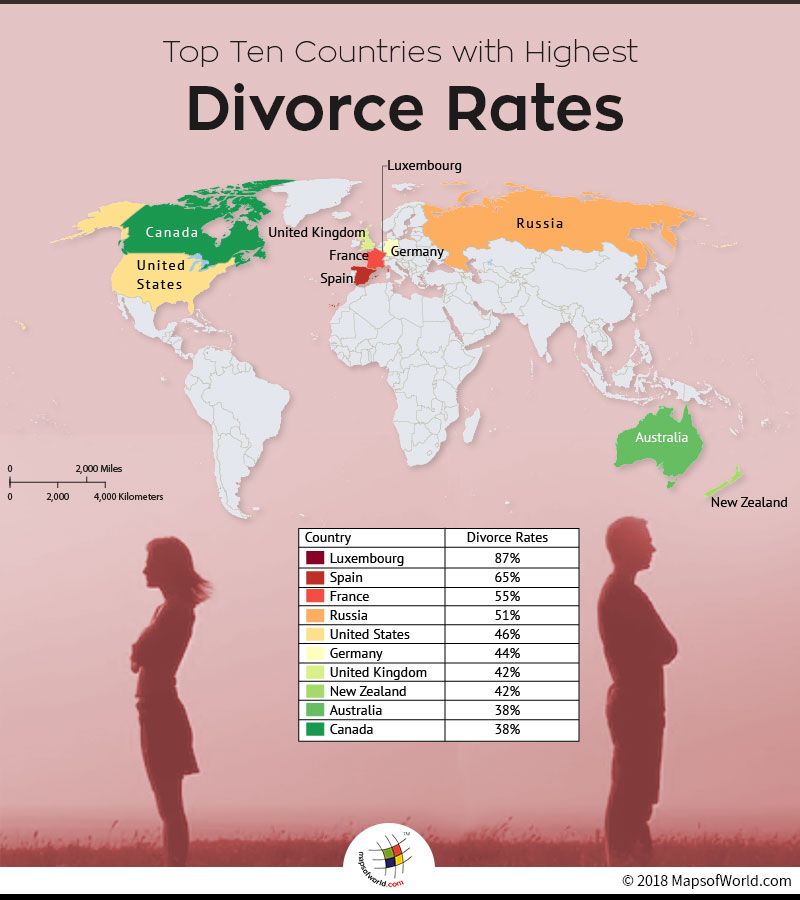 In 1990, there were 5 divorces for every 1,000 marriages. In 2015, this figure doubled, according to the Pew Research survey.
In 1990, there were 5 divorces for every 1,000 marriages. In 2015, this figure doubled, according to the Pew Research survey.
Divorce rates by generation
According to the U.S. Census Bureau’s Community Survey and the Pew Research report, the number of divorces per 1,000 individuals declines through each 10-year age group, as well as senior citizens 65 and older.
- Although the number of divorces declined country, Boomers’ divorce rate has doubled from 5 to 10 divorces per 1,000 since 1990, according to research. They got to 15 divorces in 2017.
- In 2020, the Baby Boomers’ divorce rate (for adults aged 55 to 74) was 34.9%. This age group has been in the lead regarding the number of divorces since the late 20th century.
- Gen X divorce rate is 18 divorces per 1,000 people, putting this generation and the Millenials at the bottom of the divorce rate table.

- Millennials’ divorce rate (people 25 to 34 years old) dropped by 30% over the last years - from 33 to 23 per 1,000 people.
- Gen Z divorce rate (15 to 24-year-olds) has decreased by roughly 40% from 47 to 27 divorces per 1,000 people.
How does age impact marriage?
The marriage rate has fallen in the last decades, primarily because of the Millennials. They are also the only age group to see a reduction in both divorce and marriage rates. According to a 2020 report by Pew Research:
- Baby Boomers’ marriage rate was quite impressive when they were 18 to 32 years old - 68%.
- Baby Boomers’ marriage rate is the second highest after the “Silent Generation,” with an 85% marriage rate in 1968.
- The Gen X marriage rate for the same age group in 2003 was 66%.
- The Millennials’ marriage rate is among the lowest - 55% of adults aged 18 to 32 in 2019 were married.
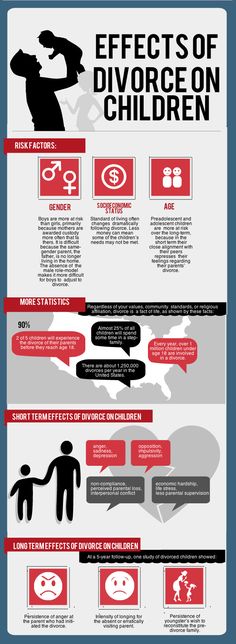
- The Gen Z marriage rate is still relatively low compared to other generations - only 8%.
The reports posit that events such as the Great Recession of 2008, increasing home prices, and the high financial burden of student loan debt that millennials incur create barriers to marriage and creating a family.
How does age at marriage impact the likelihood of divorce?
Young age at first marriage is generally a high-risk factor for getting a divorce. For example, the Institute for Family Studies research shows that people who get married before they turn 20 have a 32% likelihood of getting divorced in the first 5 years of marriage.
Marriages concluded between 20 and 24 years old are 20% likely to end in divorce, while marriages at 25-29 end in 15% of cases.
Couples who tied the knot at 30-34 are the strongest, with only 14% of divorces. And lastly, marriages entered after 35 years old are at relatively high risk (19%) of breaking down.
According to the most recent estimates, the average age of those getting married for the first time in 2021 was 28.6 for women and 30.6 for men.
How does education impact divorce?
Surveys show that divorce rates depend on education level. So, the more educated a person is, the more likely they will stay married.
The National Center for Health Statistics found that 78% of college-educated women were still married 20 years later, compared to women who only have a college diploma.
These are the divorce rates for those with different education levels:
- Less than high school: 16.4 divorces per 1,000 individuals
- High School: 16.4 divorces per 1,000 individuals
- College degree: 20.4 divorces per 1,000 individuals
- Bachelor’s degree: 14.1 divorces per 1,000 individuals
- Master’s degree: 12.5 divorces per 1000 individuals
What is the divorce rate by ethnicity?
Different studies show that African-American women are more likely to get divorced than women of other races. Sociologists suggest that it may be because of lower income and job prospects.
Sociologists suggest that it may be because of lower income and job prospects.
These are the divorce rates of each ethnicity as of 2018 per 1,000:
- The black divorce rate is the highest among other races: 30.8
- The Hispanic divorce rate is the second highest: 18.5
- The white divorce rate makes up almost half of the Black divorce rate: 15.1
- The Asian divorce rate is the lowest among other races: 12.4
What race has the highest divorce rate
Black adults have the highest divorce rate and the lowest marriage rate. But according to research, they also marry at later ages: 32 for men and 31 for women.
Black women are the only group among other races with a number of divorces higher than the marriage rate. In 2018, there were 31 divorces among the Black population and 17.3 marriages per 1,000 people.
The share of ever-divorced Black women was 38. 9% per 1,000 married women in 2016, compared to 34.4% for Whites, 13.9% for Asians, and 33.7% for Hispanic-origin women.
9% per 1,000 married women in 2016, compared to 34.4% for Whites, 13.9% for Asians, and 33.7% for Hispanic-origin women.
Black adults also make up the largest share of the never-married group. Notably, 79% of 25-29- year-old Black women and 18% of 55-year-olds were never married as of 2016.
How does race impact marriage and divorce?
Ethnicity is one of the notable predictors of divorce. For instance, Asian Americans have traditionally shown the lowest divorce rates of all other races. Currently, it’s 12.4 divorces per 1,000 people, with at least one divorce for 18% of Asian American women and 16% of men.
Hispanic-origin Americans are the second largest group regarding the number of divorces. An average of 18.5 marriage dissolutions were registered in 2018 among the representatives of this ethnicity, 30% of them being women and 27% being men.
White (Caucasian) Americans fall third with 15.1 divorces for 1,000 people. Specifically, 38% of White women and 36% of men have been divorced at least once.
Finally, Black Americans divorce at the highest rate compared to any other ethnicity in the U.S. In Particular, they had 30.8 divorces per 1,000 people in 2018.
Are children of divorce more likely to experience divorce themselves?
Different studies suggest that children of divorced parents may experience divorce as adults. For example, a 2008 study by S. Whitton from Boston University indicates that parental divorce causes lower levels of commitment towards marriage in the children.
Another study by researchers Paul Amato and Danelle Deboer found that if a woman’s parents divorced, her chances of getting divorced increased by 69%. They also suggested that if both of a married couple’s parents divorced, the possibility of their divorce increased to 189%.
However, many predictions and suggestions have not been adequately tested so far.
Divorce rate by occupation
The most traditional opinion on the connection between divorce rates and occupation is that low-paid jobs create more friction and financial instability, leading to divorce.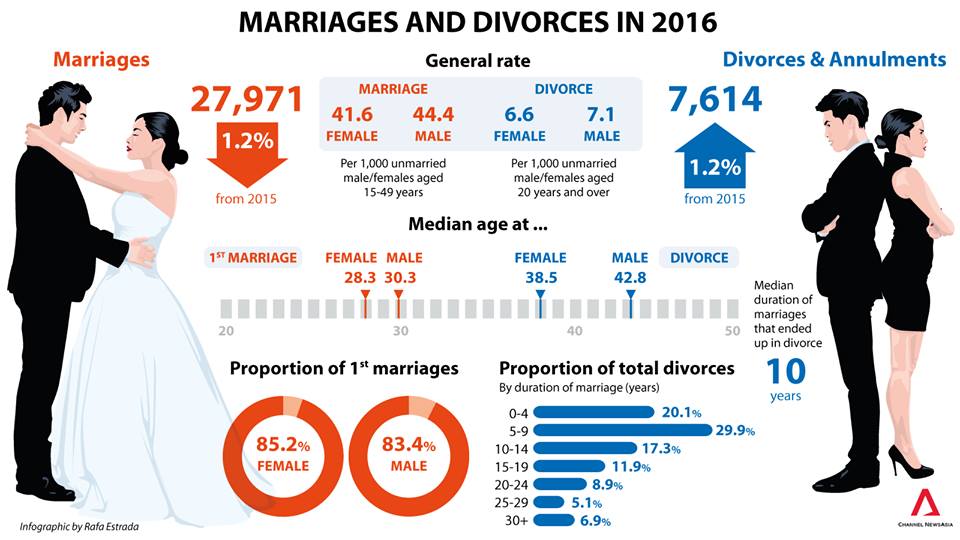
As it turns out, money doesn’t necessarily determine whether people get divorced.
Sometimes an occupation’s atmosphere also impacts a married couple’s relationship, ultimately making some call it quits.
These are the 10 occupations with the highest divorce rates:
- Gaming and casino managers: 52.9%
- Bartenders: 52.7%
- Flight attendants: 50.5%
- Gaming services workers: 50.3%
- Rolling machine setters: 50.1%
- Switchboard operators: 49.7%
- Extruding machine operators: 49.6%
- Telemarketers: 49.2%
- Textile knitting operators: 48.9%
- Compacting machine operators: 48.8%
Divorce rate by religion
Pewresearch.org found that the highest divorce rates are among the Historically Black Protestant church attendees, while the lowest is among Hindus.
- Historically Black Protestants: 19% divorced in the U.
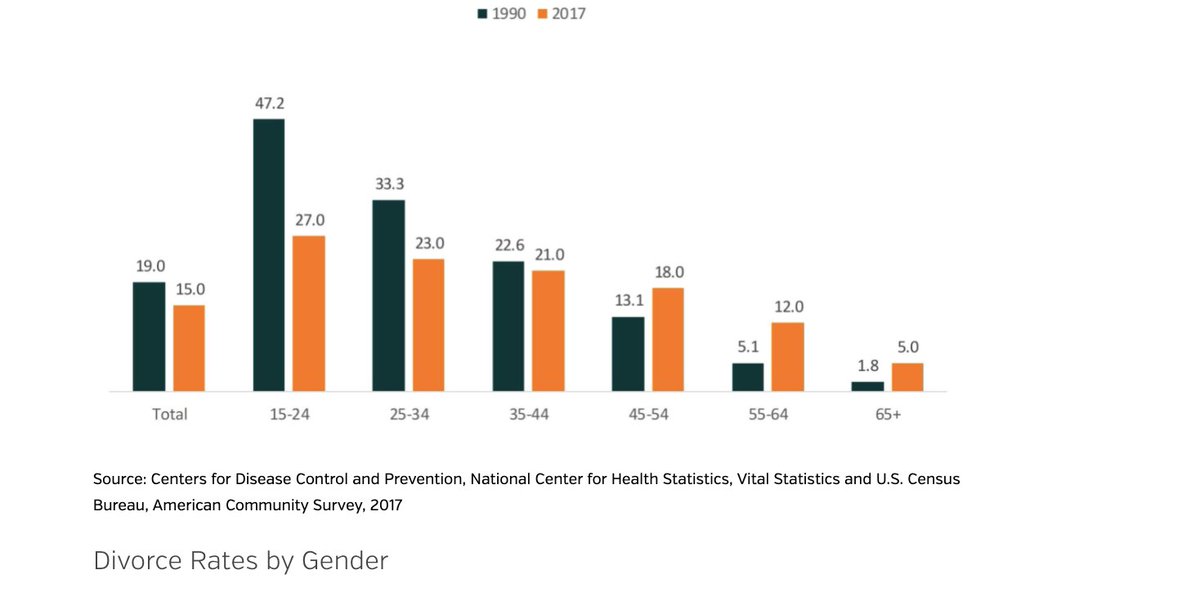 S.
S. - Evangelical Protestant: 14%
- Catholic: 12%
- Jehovah’s Witness: 12%
- Mainline Protestant: 12%
- Unaffiliated: 11%
- Buddhist: 10%
- Jewish: 9%
- Orthodox Christian: 9%
- Muslim: 8%
- Mormon 7%
- Hindu: 5%
Divorce rates of same-sex marriages
Census.gov analysis of same-sex couples households in 2019 shows that there were 53.4% of female married couples compared to 46.6% of male spouses.
The divorce rate for same-sex couples had risen from 1.1 per 1,000 people since 2015 when these marriages became legal nationwide. In 2017, about 5% to 6% were divorced, and 2.1% were separated.
Same-sex couples are 50% more likely to get divorced than different-sex couples.
Studies also found that lesbian couples are more likely to divorce if they have children. For example, 12.3% of two-female couples break up within the first 5 years of marriage compared to 2% of gay spouses.
For example, 12.3% of two-female couples break up within the first 5 years of marriage compared to 2% of gay spouses.
Divorce rates for military couples
The divorce rate among military members was 3% - 3.1% in 2017 and was almost the same as for non-military couples who had 3.2% of divorces. In 2019, 30,608 military marriages ended in divorce.
Military members under 30 years old enlisted in air weapons and tactical operations have higher divorce rates than other military positions.
The highest divorce rate was among the Marine Corps and the Air Force - 3.3%. The Navy divorce rate was the lowest - 2.8%.
Military.com also shows that female enlisted officers and troops get divorced more often than men in other military positions. In particular, female officers divorced three times more than male military members.
The divorce rate of female troops in 2019 was 7%, while the divorce rate of male soldiers in the same year was only 2. 5%.
5%.
Divorce rates by political party
Republicans are more likely to get married and less likely to get divorced, according to research by W.B.Wilcox.
The most Republican-friendly states have the highest marriage rates - Utah (56%), Idaho (55%), and Wyoming (53%).
Republicans are generally happier in their marriages than Democrats, according to the studies. For example, 67% of Republican spouses, compared to 60% of Democratic couples, said they were satisfied with their marriages in the 2010-14 General Social Survey.
However, the vast majority of states with the highest divorce rates are Republican - Arkansas (10.7 divorces per 1,000 people), South Dakota (10.4), and Oklahoma (10.2). It may partly be explained by higher marriage rates than in Democratic states.
The second marriage divorce rate
The share of adults 15 years and older who married only once decreased from 54% in 1996 to 50%, according to the Census data.
The divorce rate regarding second marriages in the U.S. is 60% compared to 40% for the first marriages and 73% for the third ones, according to statistical research.
64% of people with at least a bachelor’s degree are likely to be married just once compared to all adults.
White men have the highest rate of second and third marriages, while Asian men and women have the lowest rate of remarriages.
Sources:
https://www.oecd.org/els/family/SF_3_1_Marriage_and_divorce_rates.pdf
https://www.bgsu.edu/ncfmr/resources/data/family-profiles/schweizer-marriage-divorce-ratio-demo-variation-fp-19-27.html
https://www.google.com/url?q=https://www.afi.org/about-afi/press-releases/2021/august-2021/military-marriage-day&sa=D&source=docs&ust=1666181188912947&usg=AOvVaw3DoAMLUwsCpBFMK3co-DOk
https://www.washingtonpost.com/news/wonk/wp/2014/03/27/divorce-is-actually-on-the-rise-and-its-the-baby-boomers-fault/
https://www. cdc.gov/nchs/fastats/marriage-divorce.htm
cdc.gov/nchs/fastats/marriage-divorce.htm
https://www.google.com/url?q=https://worldpopulationreview.com/state-rankings/divorce-rate-by-state&sa=D&source=docs&ust=1666181221595674&usg=AOvVaw1hdzHjTMBCXehx_wjwTZLo
https://www.google.com/url?q=https://link.springer.com/chapter/10.1007/978-3-319-71544-5_11&sa=D&source=docs&ust=1666181241111025&usg=AOvVaw0mewlmx1QmzeEdsqWafQAz
https://www.google.com/url?q=https://www.bbc.com/worklife/article/20220511-why-women-file-for-divorce-more-than-men&sa=D&source=docs&ust=1666181250671244&usg=AOvVaw2uQAzTGYyu4dJGsu7ZfG7Y
https://www.census.gov/library/stories/2020/12/united-states-marriage-and-divorce-rates-declined-last-10-years.html
https://www.census.gov/library/visualizations/interactive/marriage-divorce-rates-by-state.html
https://www.bgsu.edu/ncfmr/resources/data/family-profiles/schweizer-divorce-century-change-1900-2018-fp-20-22.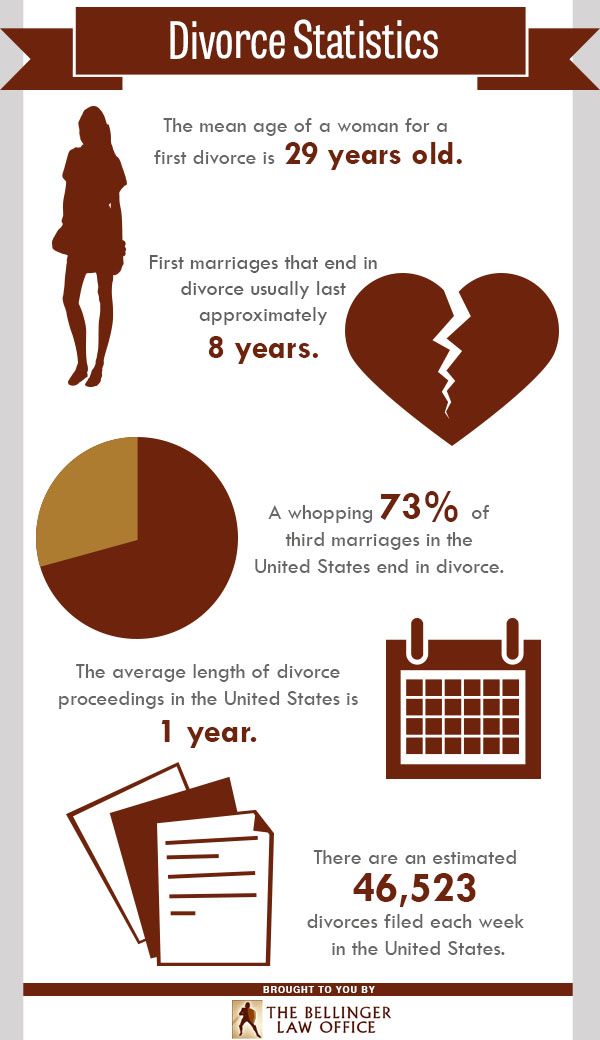 html
html
https://www.bgsu.edu/ncfmr/resources/data/family-profiles/schweizer-marriage-century-change-1900-2018-fp-20-21.html
https://www.statista.com/statistics/242030/marital-status-of-the-us-population-by-sex/
https://statisticalatlas.com/United-States/Marital-Status#data-map/state
https://www.google.com/url?q=https://www.point2homes.com/news/us-real-estate-news/the-states-where-love-lasts.html&sa=D&source=docs&ust=1666181352717192&usg=AOvVaw0hyiuewjb389GCpFbp3QDd
http://www.hopesandfears.com/hopes/city/city_index/214133-city-index-marriage-lengths
https://www.google.com/url?q=https://time.com/5434949/divorce-rate-children-marriage-benefits/&sa=D&source=docs&ust=1666181370842848&usg=AOvVaw3LRFkxtBd2u8zNsNT-3lm7
https://data.census.gov/cedsci/table?q=divorce&hidePreview=false&tid=ACSST1Y2018. S1251&vintage=2018
S1251&vintage=2018
https://worldpopulationreview.com/state-rankings/median-household-income-by-state
https://www.pewresearch.org/fact-tank/2017/09/14/as-u-s-marriage-rate-hovers-at-50-education-gap-in-marital-status-widens/
https://www.census.gov/newsroom/press-releases/2021/marriages-and-divorces.html
https://www.psychologytoday.com/us/blog/meet-catch-and-keep/202002/is-the-7-year-itch-myth-or-reality
https://www.mdpi.com/2077-1444/9/8/238
https://www.pewresearch.org/social-trends/2019/11/06/why-people-get-married-or-move-in-with-a-partner/psdt_11-06-19_cohabitation-03-07/
https://ifstudies.org/blog/replicating-the-goldilocks-theory-of-marriage-and-divorce/
https://www.bgsu.edu/ncfmr/resources/data/family-profiles/allred-gray-divorce-rate-geo-var-2017-fp-19-20.html
https://www.dailymail.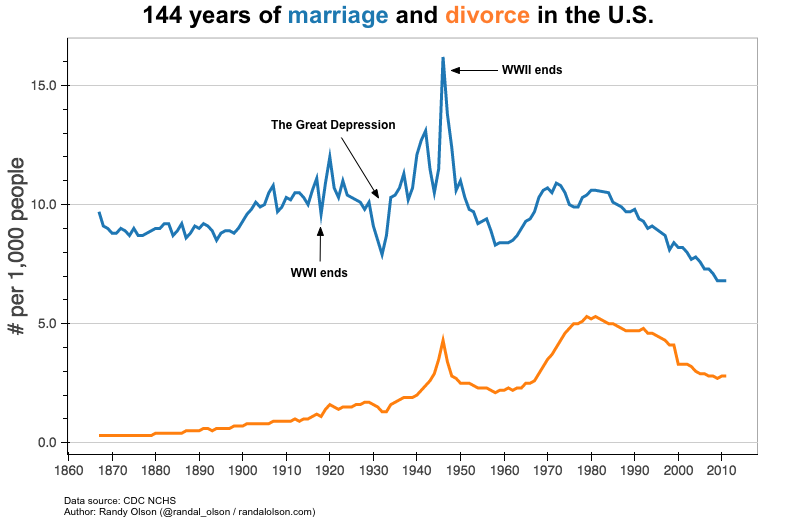 co.uk/news/article-7168243/Divorce-rate-plunges-lowest-level-40-years-except-boomers.html
co.uk/news/article-7168243/Divorce-rate-plunges-lowest-level-40-years-except-boomers.html
https://www.census.gov/library/stories/2021/04/love-and-loss-among-older-adults.html
https://www.washingtonpost.com/news/wonk/wp/2014/03/27/divorce-is-actually-on-the-rise-and-its-the-baby-boomers-fault/
https://www.pewresearch.org/fact-tank/2017/03/09/led-by-baby-boomers-divorce-rates-climb-for-americas-50-population/
https://www.pewresearch.org/fact-tank/2019/02/13/8-facts-about-love-and-marriage/
https://www.pewresearch.org/social-trends/2020/05/27/as-millennials-near-40-theyre-approaching-family-life-differently-than-previous-generations/
https://www.census.gov/content/dam/Census/library/working-papers/2018/demo/SEHSD-WP-2018-09.pdf
https://ifstudies.org/blog/want-to-avoid-divorce-wait-to-get-married-but-not-too-long
https://www.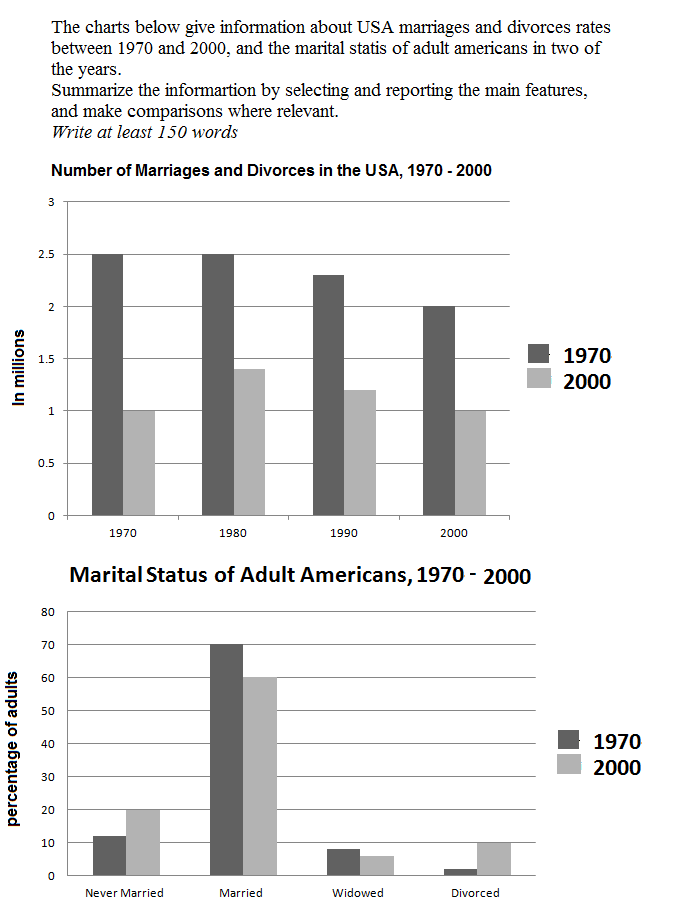 statista.com/statistics/371933/median-age-of-us-americans-at-their-first-wedding/
statista.com/statistics/371933/median-age-of-us-americans-at-their-first-wedding/
https://www.washingtonpost.com/news/wonk/wp/2016/04/06/who-gets-divorced-in-america-in-7-charts/
https://www.pewresearch.org/fact-tank/2015/12/04/education-and-marriage/
https://www.census.gov/content/dam/Census/library/publications/2021/demo/p70-167.pdf
https://psycnet.apa.org/record/2008-14158-014
https://onlinelibrary.wiley.com/doi/abs/10.1111/j.1741-3737.2001.01038.x
https://www.businessinsider.com/you-have-these-10-jobs-youre-more-likely-get-divorced-2019-10#1-gaming-managers-529-1
https://www.pewresearch.org/religion/religious-landscape-study/marital-status/
https://www.census.gov/library/stories/2021/04/how-people-in-same-sex-couples-compare-to-opposite-sex-couples.html
https://www.cnbc.com/2017/11/10/same-sex-divorce-poses-complications-for-some-splitting-couples. html
html
https://www.tandfonline.com/doi/abs/10.1080/01494929.2019.1630048
https://www.ncbi.nlm.nih.gov/pmc/articles/PMC4460604/
https://www.military.com/daily-news/2018/03/21/troop-divorce-rate-unchanged-marriage-rate-continues-fall.html
https://www.denisgravel.com/blog/2021/12/divorce-rates-for-military-couples-show-a-higher-risk-of-breakups/
https://news.virginia.edu/content/study-challenges-which-political-party-linked-happier-marriage
https://www.census.gov/content/dam/Census/library/publications/2015/acs/acs-30.pdf
https://www.huffpost.com/entry/second-third-marriages-divorce-rate_n_1324496
Contents:
Lawyers in New York (USA) - Bukh Global
We solve legal problems of any complexity on an international scale
Bukh Global Law Firm is more than a close-knit team of experienced and qualified Russian-speaking professionals in New York. We position ourselves first of all as reliable and responsive assistants who will do everything possible to successfully solve the client's problems. We are not afraid of difficulties, we take on even the most difficult and hopeless cases. Focus on results and maximum perseverance, multiplied by deep knowledge of various areas of international and American law, make it possible to guarantee the effectiveness of the legal assistance provided!
We position ourselves first of all as reliable and responsive assistants who will do everything possible to successfully solve the client's problems. We are not afraid of difficulties, we take on even the most difficult and hopeless cases. Focus on results and maximum perseverance, multiplied by deep knowledge of various areas of international and American law, make it possible to guarantee the effectiveness of the legal assistance provided!
Bukh Global is an international law firm. We have experience in successfully resolving disputes in courts and state bodies of various countries. We work not only in European, but also in more exotic Asian and African states. Regardless of the complexity of the dispute and the chosen jurisdiction, we always help to find the most effective and beneficial option for the client to solve the existing legal problem.
Please note that we are ready to provide high-quality legal assistance in the most diverse categories of cases with a foreign element. At the same time, we do not limit ourselves to consultations and representation of clients in court, but we provide the widest possible range of services from lobbying interests to supporting transactions of any scale and level of complexity.
At the same time, we do not limit ourselves to consultations and representation of clients in court, but we provide the widest possible range of services from lobbying interests to supporting transactions of any scale and level of complexity.
An important advantage is the clear specialization of the lawyers of the law office "Bukh Global" in specific areas of law. Thanks to this, we thoroughly understand the features and nuances of each case under consideration. With us, your chances of success are maximized!
-
Law
- ” International “
- ” Criminal “
- ”Family “
- ” Civil “
- Immigration
Law firm "Bukh Global" provides qualified and timely legal assistance in a wide variety of areas of international law. Thanks to the presence of a whole team of experienced lawyers, we are ready to understand even the most complex nuances of international and national legislation.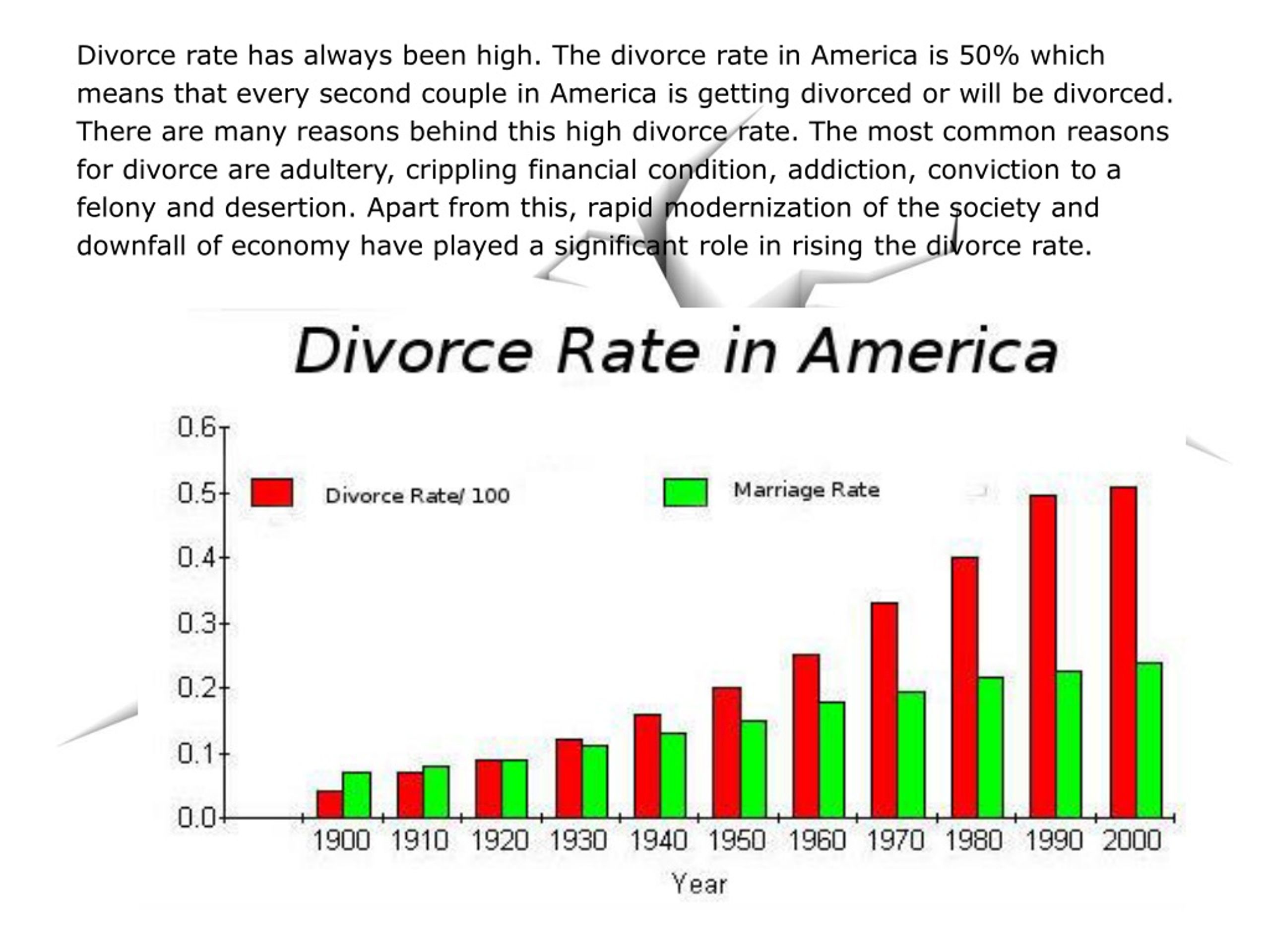 Thanks to this, we provide really high-quality and effective protection of your rights and interests.
Thanks to this, we provide really high-quality and effective protection of your rights and interests.
We successfully cooperate with both private clients and large corporations, governmental and non-governmental organizations, various financial institutions. We are always open to fruitful work, enthusiastically take on the resolution of non-standard disputes and take into account the wishes of customers. Learn more about the branches of international law with which we work
More about international law
Arkady Bukh: Why should you contact us?
Penalties for criminal offenses are generally the most severe. Depending on the degree of danger of the committed act, offenders can get by with fines and community service, as well as life imprisonment or even the death penalty. Therefore, it is so important to receive high-quality legal protection in the event of criminal prosecution against you or close people.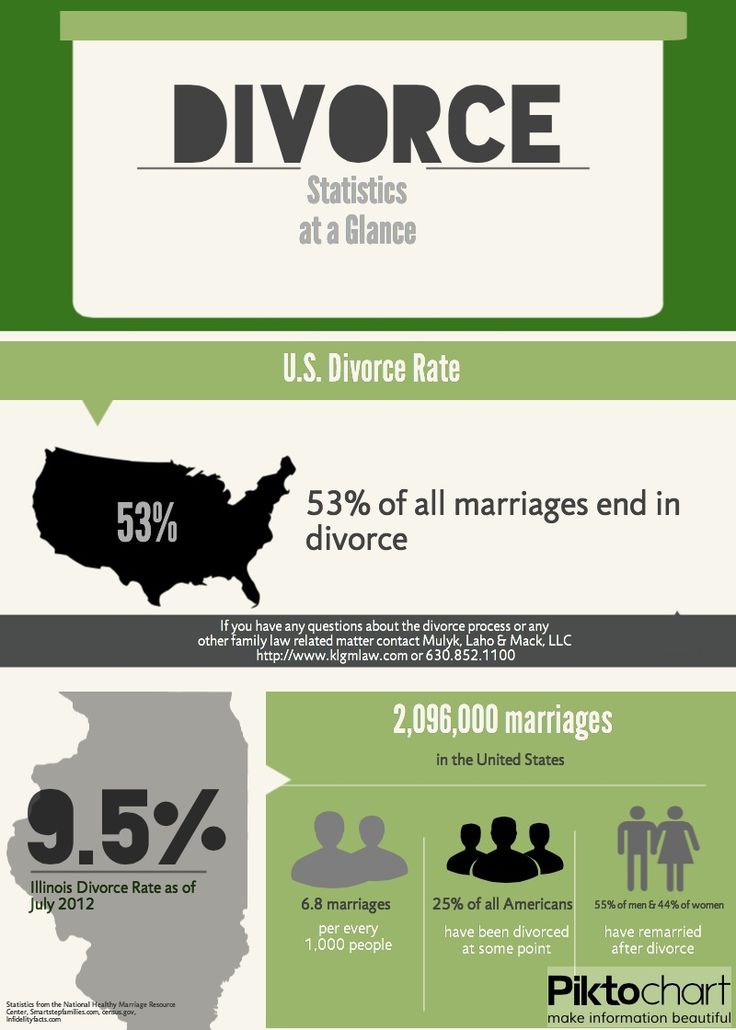
Bukh Global lawyers have vast experience in defending clients in criminal cases of various categories. We will provide you with high-quality and comprehensive protection against charges of drug trafficking, tax evasion, money laundering, economic and many other crimes. We develop the most effective line of defense that helps to avoid or minimize punishment!
Learn more about US Criminal Law
Arkady Bukh: Why should you contact us?
Family litigation is an extremely delicate category of cases. Here, the lawyer becomes not just a lawyer, but even a psychologist, who often, thanks to competent argumentation, helps to save a family or dissolve a marriage on mutually beneficial terms while maintaining good human relations between former spouses. In their work, experienced lawyers of Bukh and Partners resolve disputes that have arisen amicably and exclusively within the framework of the current legal field.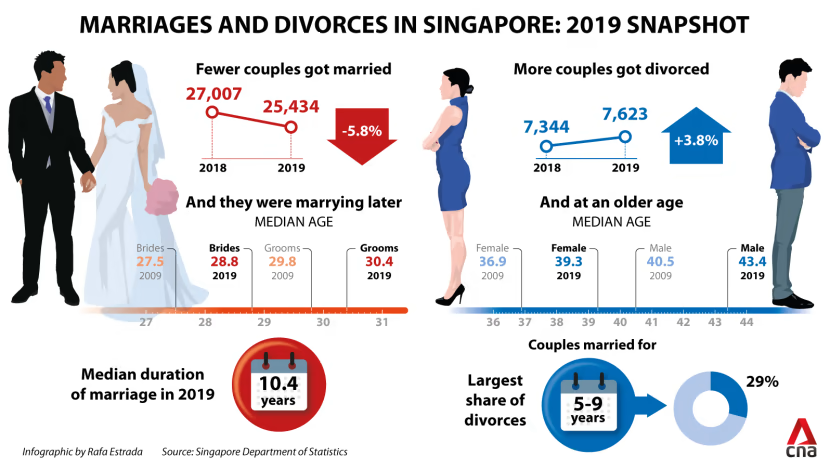
Qualified lawyers work with a variety of family matters from helping draft marriage contracts and mediating family disputes to legally organizing moves abroad with children and helping to return children. Regardless of the complexity of the situation, we guarantee effective protection of your rights and interests!
More about US family law
Arkady Bukh: Why should you contact us?
Civil disputes can definitely be called the most common category of cases heard in the courts of any country. Of course, without the help of a qualified lawyer, in most cases it is extremely presumptuous to hope for a successful consideration of the case and the adoption of an acceptable decision by the court. Therefore, in the event of civil proceedings, we recommend that you seek help from experienced lawyers of the Bukh and Partners law office as soon as possible.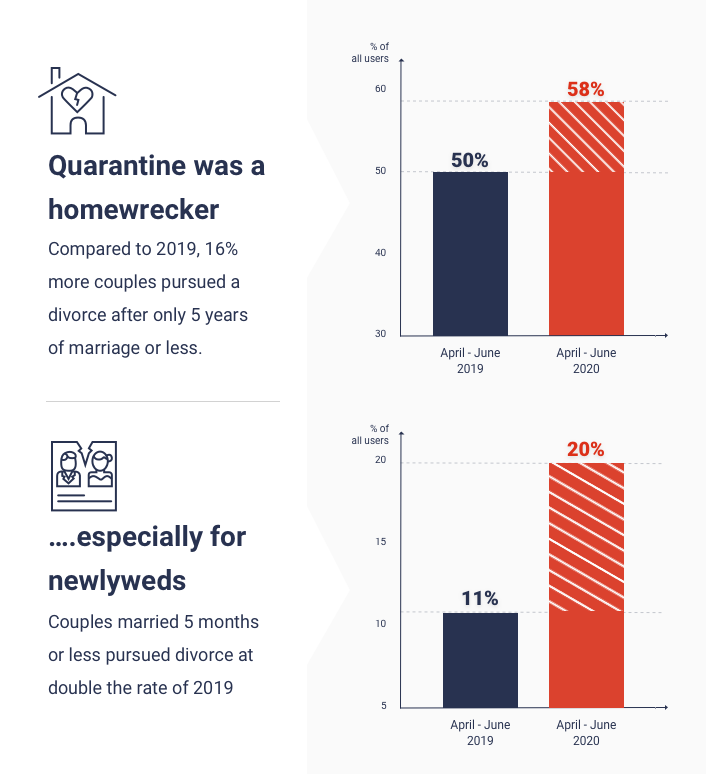
Our lawyers will thoroughly study all the details of the case, collect the most complete evidence base, if necessary, negotiate with the opposite side and do everything possible to achieve the task. We guarantee the most responsible approach, attention to even the smallest details and impeccable service!
More about US civil law
Arkady Bukh: Why should you contact us?
Immigration to the USA and leading European countries is a dream for many people living in the countries of the former Soviet Union. Bukh & Partners Law Office helps make this dream a reality. Thanks to the accumulated experience, we help to choose the most optimal immigration program, taking into account the needs and wishes of the client. In addition to legal assistance, we provide assistance in acquiring real estate in the United States of America and other organizational support.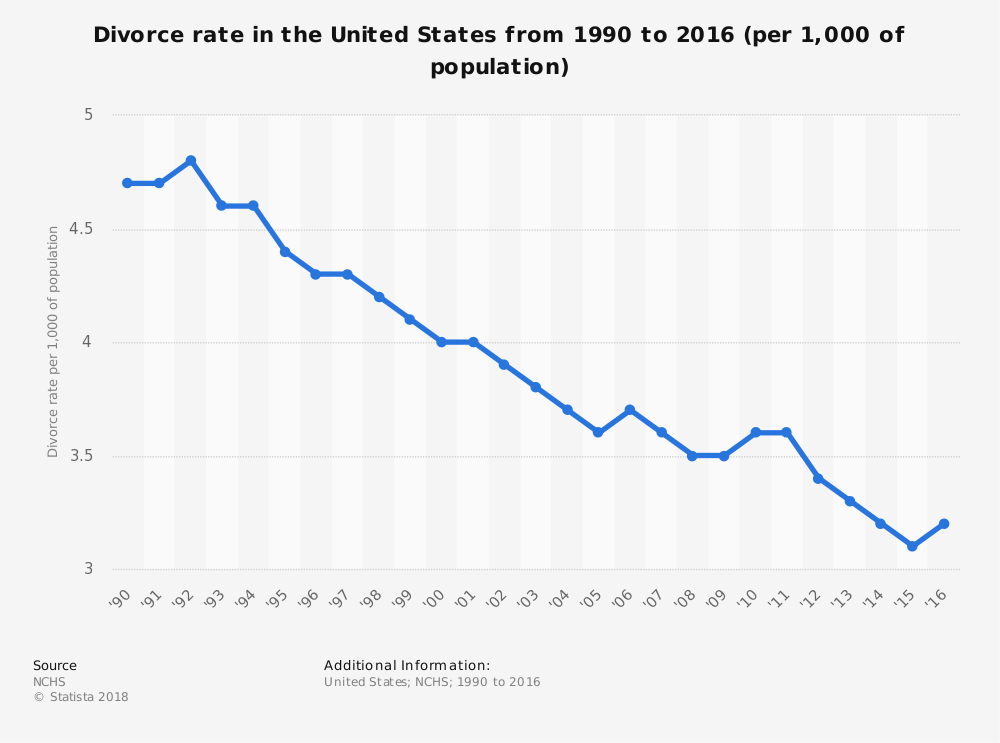
Additionally, if necessary and in the presence of relevant circumstances, we help to obtain political asylum in the United States or a visa for domestic violence. We successfully resolve disputes with US immigration services and greatly simplify the process of obtaining a visa for clients and their families. Moving to America is easy with us!
More about immigration to the USA
Arkady Bukh: Why should you contact us?
Score for
Copyright © 2013
divorces in the USA 2022 statistics | Russian Bazaar
America
No. 195 (1326)
Vadim Dymarsky
The next year is almost guaranteed to set a historical record for the number of divorces. Experts predict more than 1.7 million divorce cases, more than double the rate before the Covid-19 pandemic. Vivid evidence of this is the courts opening all over the country, where long piles of documents (divorce cases) from family lawyers (family lawyers) arrive daily.
Experts predict more than 1.7 million divorce cases, more than double the rate before the Covid-19 pandemic. Vivid evidence of this is the courts opening all over the country, where long piles of documents (divorce cases) from family lawyers (family lawyers) arrive daily.
The worst situation is observed in the city of New York, where the exact statistics of divorces are now completely classified. Authorities in the Big Apple and marriage-promoting non-profits believe that unprecedented divorce rates will only push couples with less than ideal relationships to a permanent breakup.
The New York divorce lawyers themselves are preparing for a sharp increase in profits. Many say their office phones are "ringing non-stop" and the most popular client question is "when can I meet with a lawyer and start divorce proceedings."
Needless to say, the leading cause of the divorce avalanche is the Covid-19 pandemic, which has forced husbands and wives to spend more time with each other. Long-term isolation under one roof has turned into psychological torture for many couples.
Long-term isolation under one roof has turned into psychological torture for many couples.
This effect is well described in the psychology of forensic science: prisoners who have lived in the same cell study each other so well during the years of their imprisonment that at the end of their term they most of all dream of a solitary confinement cell (not a punishment cell / solitary confinement, but a cell for one). Cellmates can remain on friendly terms, but they do not want to see each other.
The avalanche of divorces predicted in 2022 coincided with another phenomenon - the extinction of the institution of marriage. If at 19In 60, only 13% of American adults lived in complete solitude (live alone), now their number is rapidly approaching 50%. If we consider single mothers living with relatives (but not with husbands / wives, partners) who prefer to be married rather than live together (one of the fastest growing social categories) to be “single”, then 24/7 couples living together will be less than 25% of the total population.
Experts give the following forecasts for marriages / divorces in 2022.
The average duration of the divorce process in the United States for the first time will exceed 18 months.
This is an incredibly long time that will require incredible patience from husbands and wives.
In New York, even the simplest divorce by mutual consent can exceed 24 months. If the spouses are going to share property, children and settle other differences, then the legal process can take 48-60 months.
An excessively slow divorce machine will hit the institution of marriage even harder. Hundreds of thousands of ex-husbands and wives, after receiving divorce certificates, can promise themselves never to marry again. You can live under one roof without beautiful weddings / ceremonies.
The average age of a man entering into marriage for the first time in the US will rise to 32 years, and women - up to 30 years 6 months.
If millennials (Millennials - born from 1981 to 1996) are extremely reluctant, but still marry, then representatives of generations Z (from 1997 to 2012) and Alpha (from 2013 to 2025) will overwhelmingly neglect this procedure .
The most interesting thing is that adults will not find a single sound argument explaining the necessity (and most importantly, the benefits) of marriage. The moral and ethical qualities of a person do not become stronger after strict adherence to a number of religious rules. Marriage Certificates do not add honesty, devotion and responsibility to your loved one.
The average duration of the first marriage will decrease from the current 8 to 6 years.
Unlike their parents and grandparents, American youth are extremely pragmatic thinkers. Today, no one believes in the stories described in romantic melodramas, how couples of lovers get married at the age of 18-22 and live to a ripe old age (or even more fantastically, they die on the same day).
The real estate market feels the fragility of modern marriages best. 30-year mortgages are forced on families solely because of the average house sale 6 years and 6 months after purchase. Banks and real estate experts earn extra money from this. If all couples really paid off 30-year mortgages (at first, couples are sure that they will), then the Real Estate Market would change beyond recognition.
Women will be the first to file for divorce not in 66% of cases, as at present, but in 73%-75% of cases.
Here everything is explained quite simply. A new round of struggle for women's rights (MeToo movements, Equal Pay for Equal Work, etc.) strengthened their independence. Women have become more independent and free. Their inherent gift of foresight makes it possible to calculate the family situation for several years ahead. Men tend to be more conservative and cautious. They often experience fear of divorce.
Divorce Party will be more fun than a wedding.



